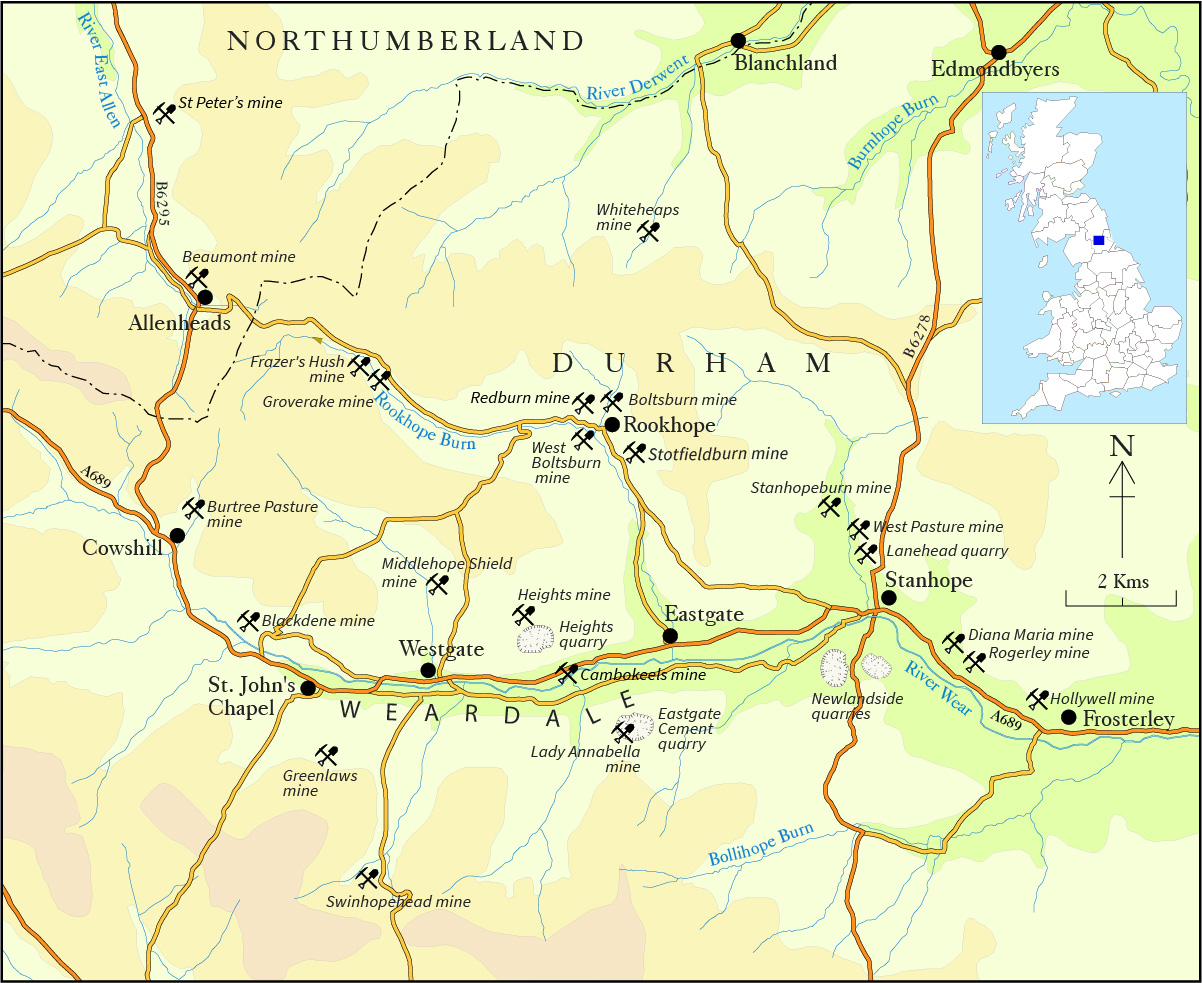Categories
Other Shop Pages
Currency
WEARDALE, Co. Durham, England
MINING HISTORY
The mining of Lead, zinc and latterly fluorite and barytes in the North Pennines is well documented going back at least 700 years and possibly back to Roman times. During much of that time however mineral working has been on a small scale and sporadic.
Mining activity in the North Pennines reach a peak in the late 18th and early 19th century with two principal companies – The London Lead Company and the Beaumont companies employing several thousand men, women and children primarily working the mines for lead. By the end of the 19th century increasing costs and competition from imported ores led to a decline in the industry. Some mines were able to exploit reserves of zinc ores to extend their life but it was the discovery in 1880 of the fluxing properties of fluorspar in steel making that revived the mining industry.
Fluorspar mining began in 1882 by the Weardale Lead Company and it was they who remained the principal producer throughout the first half of the 20th Century. After the Second World War other private fluorspar operations were consolidated and taken over by British Steel Corporation. In 1964 The mining interests of Weardale Lead Company were taken over by ICI which were in turn taken over by Swiss Aluminium (SAMUK). Much development work to find new deposits was carried out by SAMUK but in 1982 all mining interests in fluorspar came into common ownership when Minworth Ltd. took over those interests and also those of the BSC. Minworth concentrated their efforts on Frazer’s Hush and Cambokeels Mines with a processing plant at Broadwood. The company expanded rapidly buying a fluorspar mine in Canada and worked the Strontian deposit in Scotland for Barytes. However, before the decade was out they went into liquidation and Sherburn stone worked the two remaining mines until finally ending fluorspar production in 1999 with the closure of Frazer’s Hush mine. Weardale was never a significant barytes producer, economic barytes deposits being on the periphery of the area in Teesdale and Alston Moor.
Since the closure of commercial mining there remains the possibility of mineral specimens turning up from the small number of limestone quarries still operating. Few mineral collections remain in the dale most having been sold off over the years since the mines closed. However recent years has seen a number of specimen recovery projects started. Besides Rogerley mine there are now specimen recovery operations at Greenlaws mine, Diana Maria mine, Lady Annabella mine and there was for a short time one at West Boltsburn mine.
GEOLOGY
The North Pennine Orefield occupies an area of approximately 1000 Km2 within the Alston block — an area of relatively stable sedimentary rocks bounded to the North and South by faults forming the Northumberland and Stainmore troughs, to the West by the Pennine escarpment faults and to the East by Westphalian (Upper Carboniferous) rocks of the Durham coalfield: These sediments comprise cyclothem sequences of limestone, sandstone and shales deposited during Namurian/Dinantian (mid/lower Carboniferous 300 — 340Ma) times. The sediments overlie lower Palaeozoic basement rocks into which during Devonian times several granite cupolas were intruded. Isostatic adjustments of the granites rising against the overlying sediments caused the sediments to gently buckle creating a specific geometric fracture pattern. Temperature differentials between the granite and surrounding rocks led to the development of large scale convective cells whereby salt water brines expelled from overlying and surrounding shales migrated to considerable depths within the granite, leaching and forming complex mineral bearing solution before being forced upwards into the overlying fractures. As temperature/pressure conditions reduced minerals crystallised within the fractures into specific zones with a central fluorite/galena zone closely outlining the extent of the warmer Weardale/Tynehead granite cupolas, surrounded by a lower temperature zone of barite mineralisation. The fluorspar veins are commonly 2-3m in width and can be up to 20Km in length. The main fluorspar mineralisation occurs as ore shoots within the vein structure with the location of such ore shoots being controlled by the coincidence of competent (sandstone/limestone) wall rocks with favourable fault orientation reopening fractures.
SPECIMENS
The best specimens are found predominantly in ‘flat’ workings, these being horizontal areas of replaced limestone extending laterally from the host vein. The most prolific host strata for these ‘flats’ is known as the Great Limestone with a thickness of up to 22 metres.
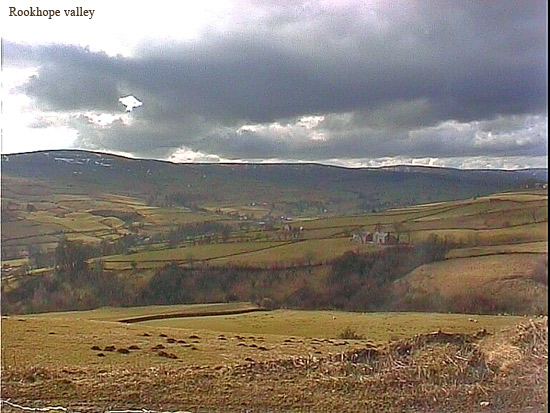
Throughout the orefield three distinct horizons in the Great Limestone are prone to flat mineralisation often hosting large crystallised cavities. At Boltsburn mine flats extending for some 7,700 feet along the vein and up to 200 feet from it, producing some of the finest fluorspar specimens in the world.
More recently in the 1980s, at Frazer’s Hush mine, a huge cavity was discovered lined with beds of purple fluorite and smaller quantities of galena, calcite and sphalerite crystals whilst, just below the 325 level at Cambokeels, zinc-rich flats were discovered containing superb fluorite and calcite. Here, after mining started in the flat, the drillers complained to the management that they couldn’t work the area because the drill rods kept disappearing into cavities!
Specimens from classic Weardale locations are becoming increasingly difficult to find due to the end of commercial mining.
MINERAL LOCATIONS
Beaumont Mine, Allenheads, Allendale, Northumberland
A 19th Century lead mine re-opened in 1969 by the British Steel Corporation via a decline and known for its specimens of lustrous wine-coloured fluorite associated with sphalerite and siderite found around 1975 from Diana vein. According to the miner who found them the fluorite was a pale green colour when first brought out.
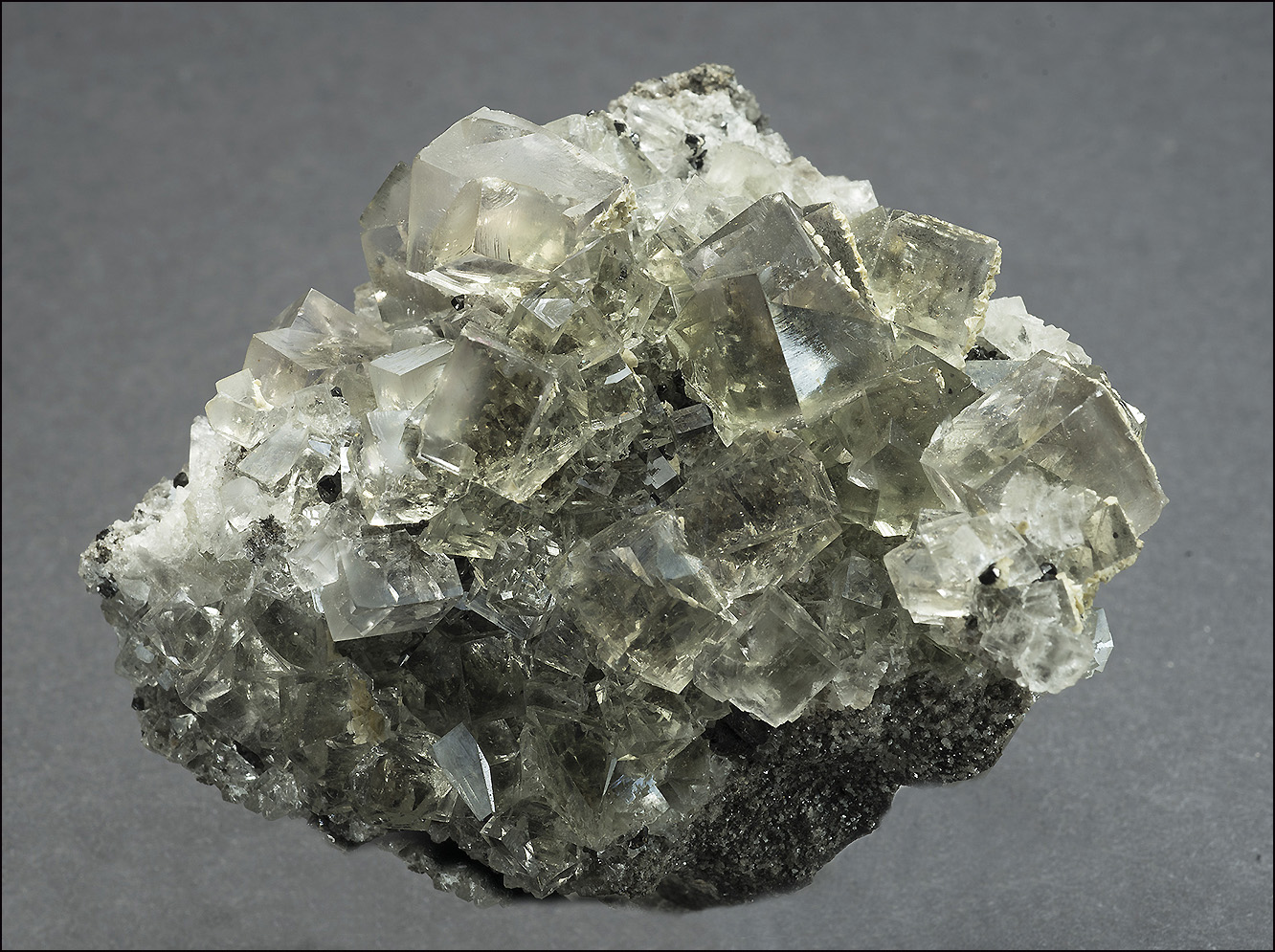
Most of the specimens finished up in Germany as the dealer involved with the major part of the find took them to the 1975 Munich show. Opaque purple fluorite cubes came from Henry’s vein too. The re-working was relatively short lived, the anticipated fluorspar reserves not materialising with the mine closing in 1981.
Blackdene Mine, St. Johns Chapel, Weardale
Also worked by the British Steel Corporation and well known for its distinctive semi-transparent purple fluorite cubes tinged a honey brown colour. Purple cubes typically up to 6cms across were found some with a scattering of smaller gemmy second-generation fluorite and often associated with bright, modified galena crystals. Rarely 2-3 cm amber fluorite twins occurred with green centres and exceptionally light blue zoning, the latter from a single cavity found when driving the incline. Larger fluorite crystals occur up to around 15cms but were usually opaque purple and white.
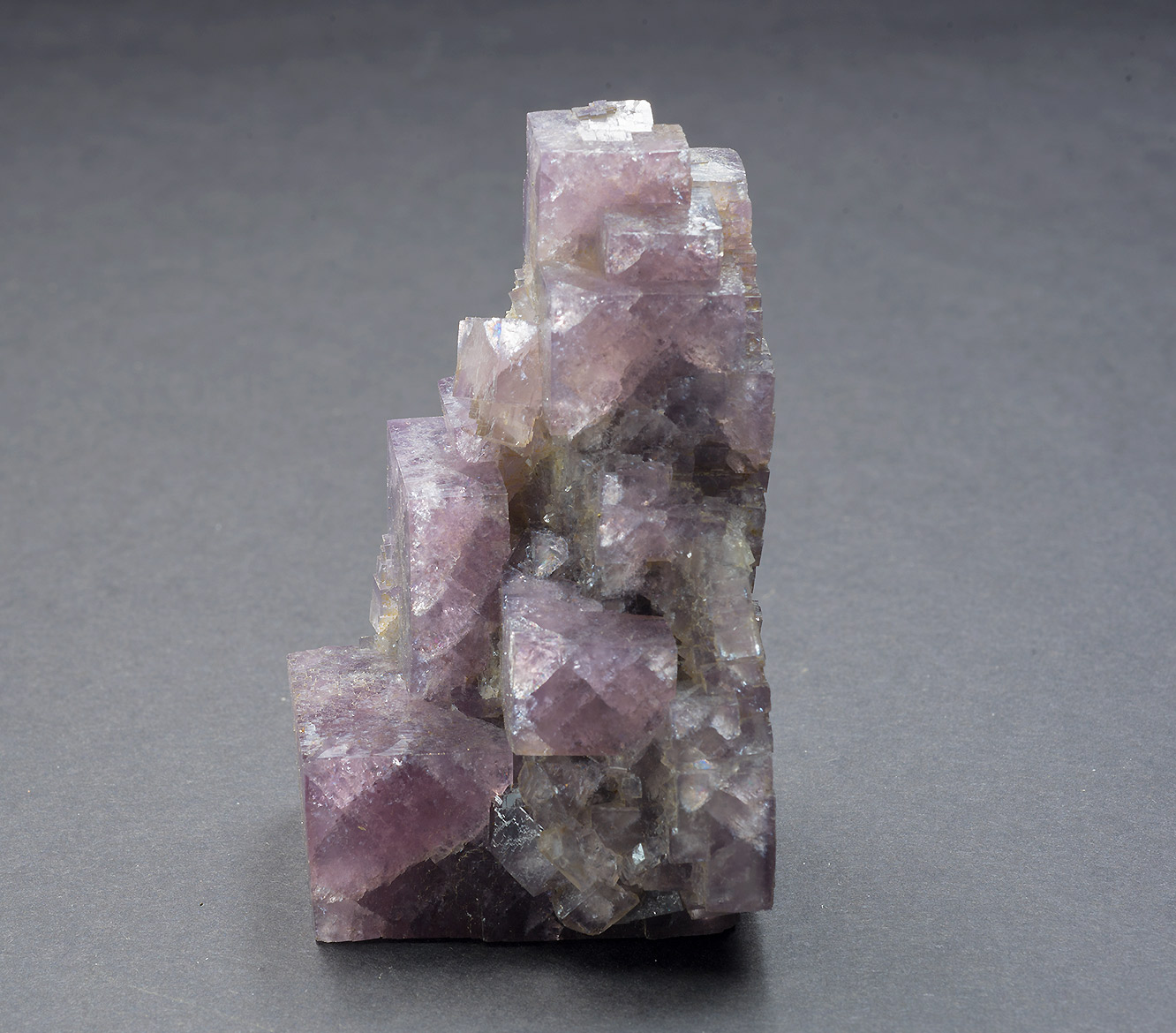
Blackdene is famous for produced some of the best elongated purple ‘floater’ crystals, forming stepped towers. A characteristic of some fluorite specimens from here is that they are dusted with small chalcopyrite crystals. From Silverdykes vein an offshoot of Slitt vein specimens of a pale straw colour were found.
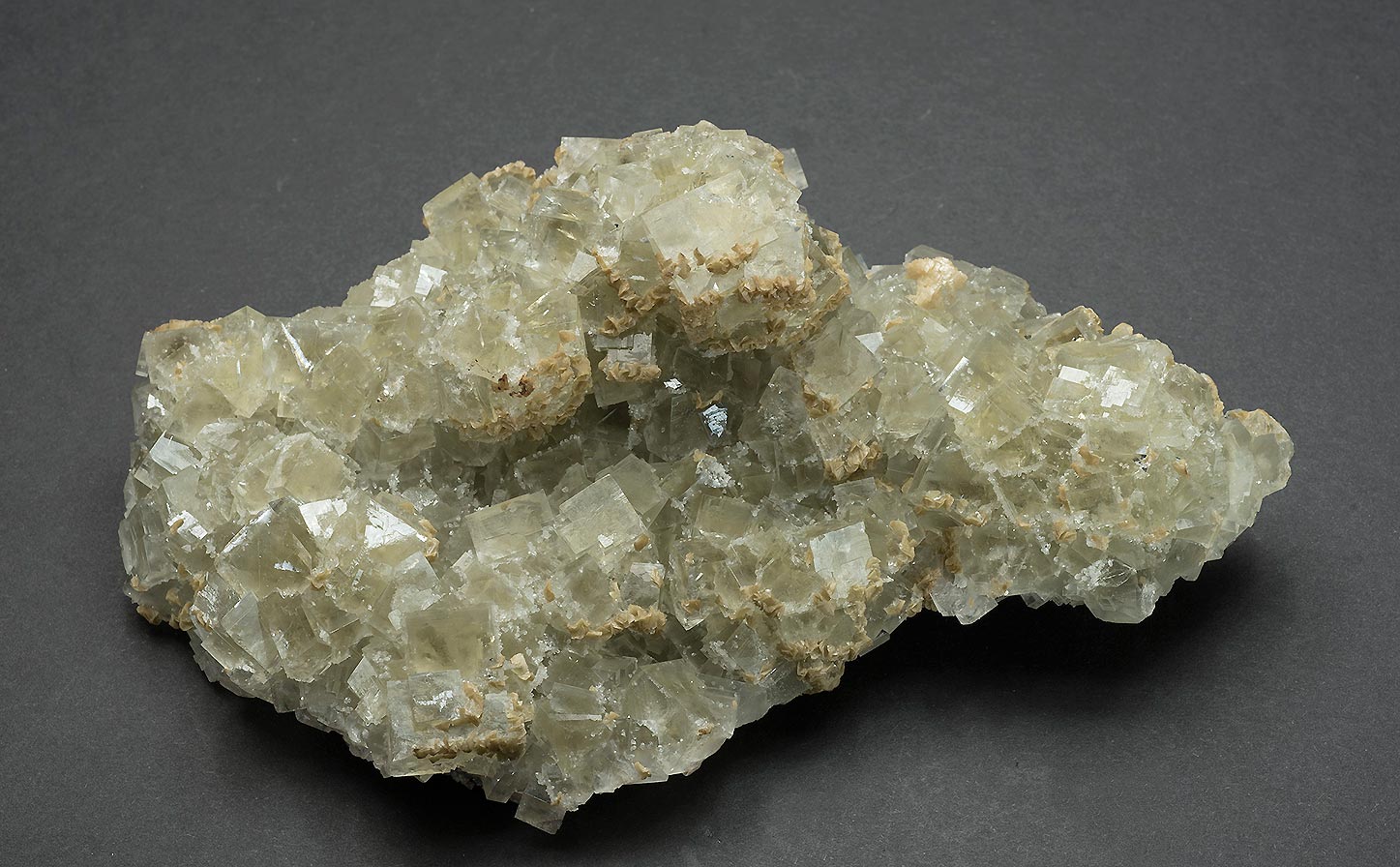
Other minerals from Blackdene include groups of modified bright galena crystals, the best found in a cavity at the bottom end of the incline. Calcite occurred in many forms sometimes with curved crystal faces and usually coating earlier fluorite whilst rarely large sphalerite ‘balls’ were found up to the size of footballs. The mine closed in 1987 all the recent workings off the incline now being flooded.
Boltsburn Mine, Rookhope
Boltsburn probably produced the most varied range of fluorite colours in Weardale (except deep green) with some of the largest and finest cubes ever found, some being of such quality that they were used in optics. The range of aesthetic specimens included combinations of fluorite with siderite, galena, sphalerite, pyrite and occasionally chalcopyrite. The mine is also known for calcite crystal stalagmites.
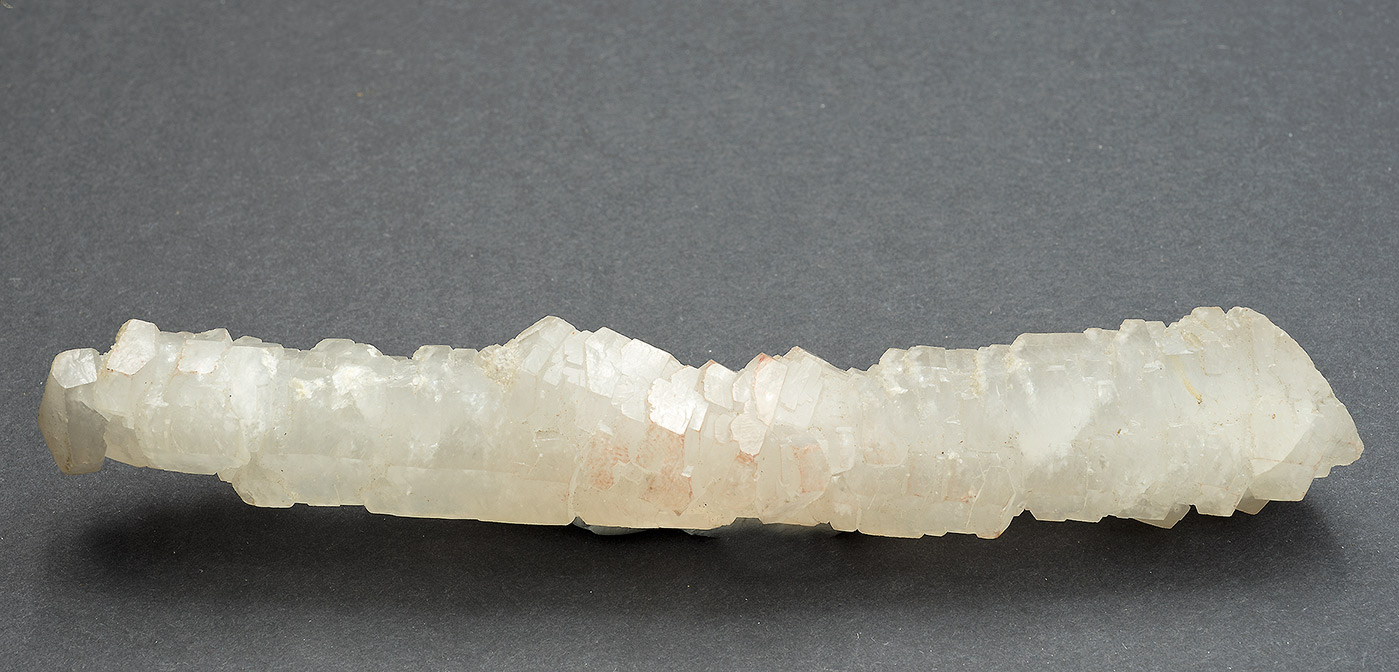
As the vein was followed in a North-East direction, extensive flats were discovered in 1892. These proved to be rich in fluorspar and the source of many of the fine specimens seen in collections and museums today. Economic reasons rather than exhaustion of the orebody caused the mine to close in 1932.
West Boltsburn Mine, Rookhope
In recent times a local group of mine explorers attempted to clear a way through numerous falls in the adit accessing the extensive ironstone flats to the SW of Rookhope. Eventually they broke through and by 2015 had gained access to a huge area of flat workings and levels running off to some of the large NW-SE veins that traverse the Rookhope valley
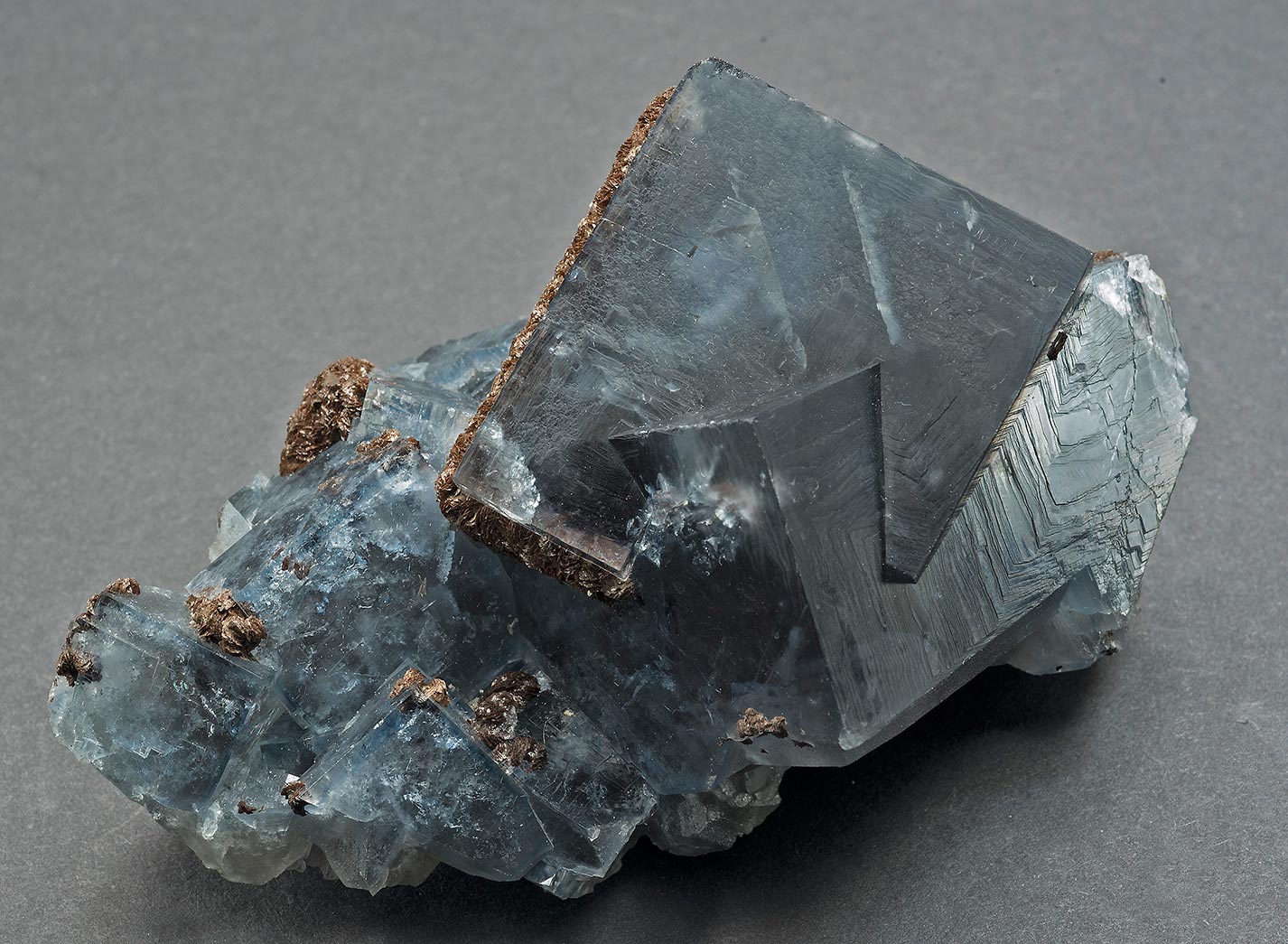
The dominant mineralisation in the flats is siderite/ankerite but in many areas fluorite, calcite and quartz are quite ubiquitous. Fluorite cubes up to around 25cms occur, mostly of a purple colour with many of the fluorite specimens being characterised by strong phantoms, unusually with zones of different colours occurring in the same crystal.
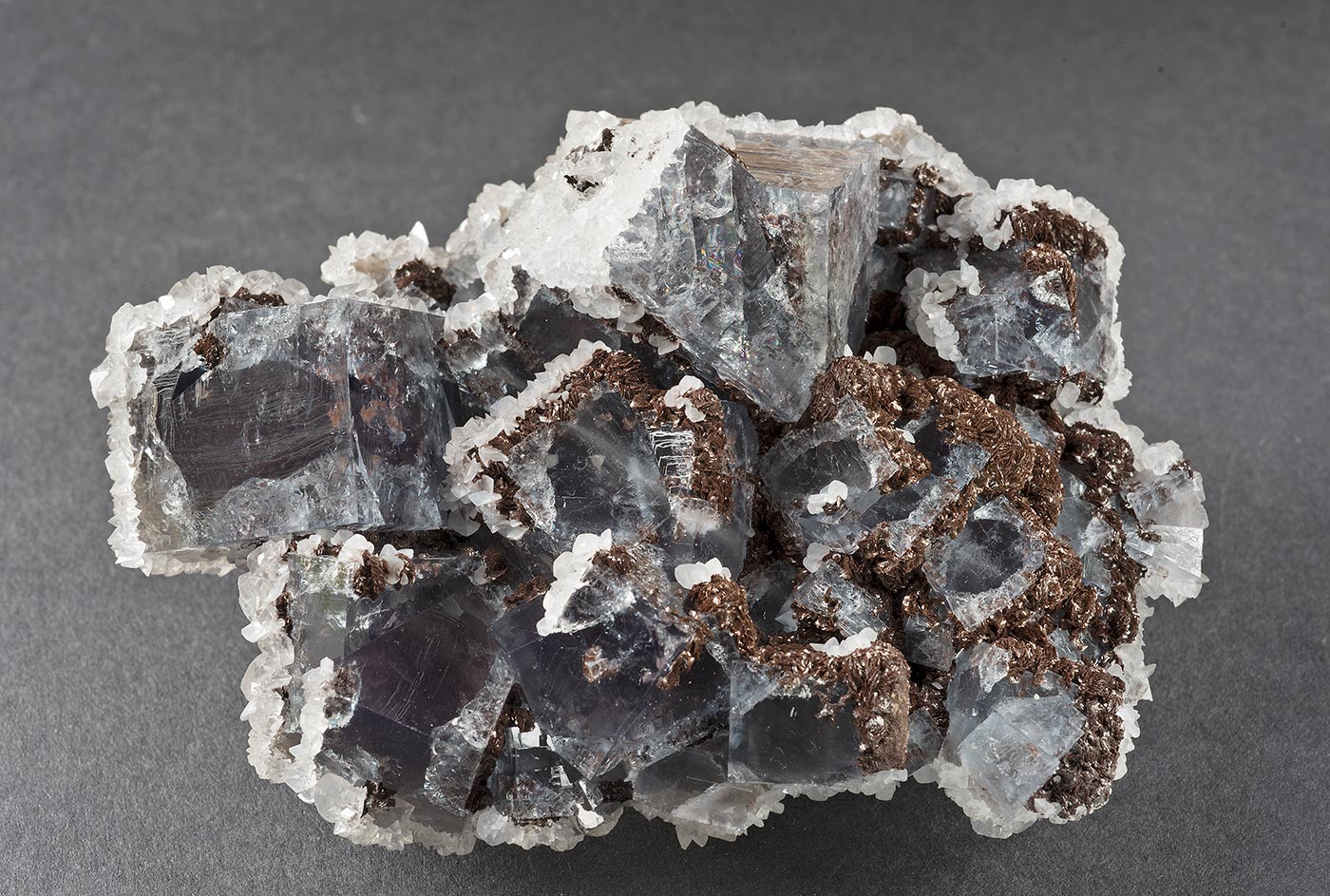
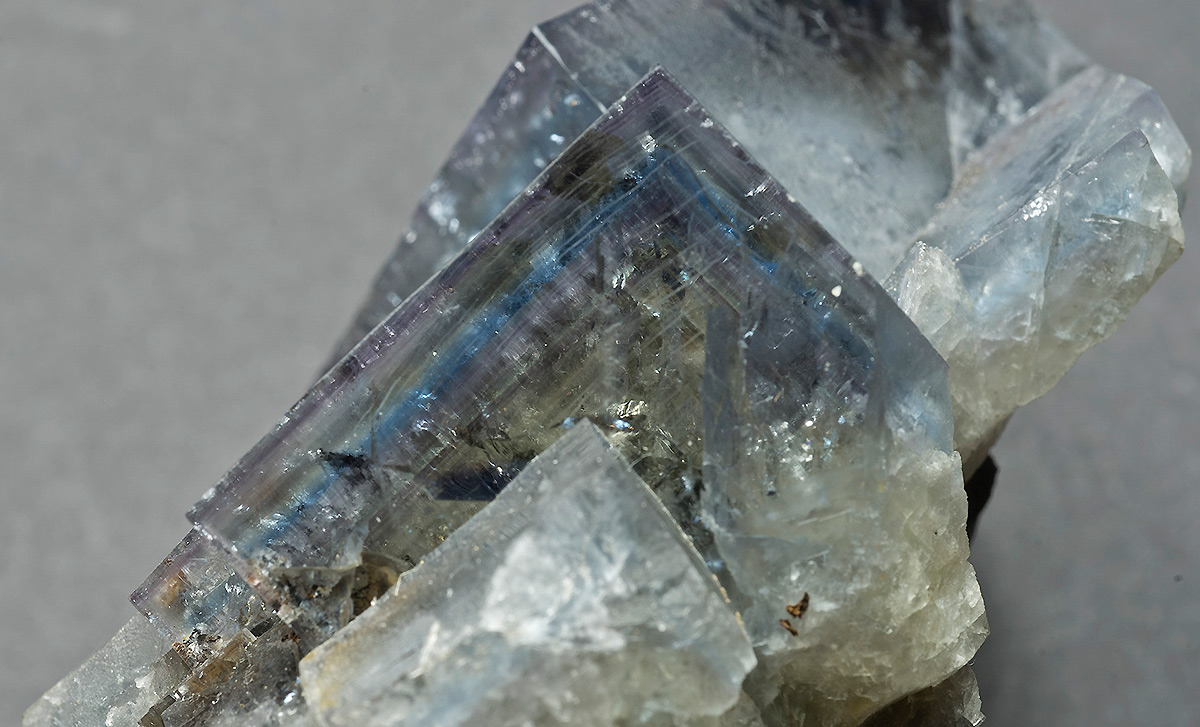
Perhaps the best specimens came out of a large cavity over a mile in from the adit entrance. The fluorite was of a rich blue colour, more like that of West Cumbria, associated with small white calcite crystals and brown siderite/ankerite.
Broadwood quarry, Frosterley, Weardale
In the 1980s and 1990s fluorspar mined at Cambokeels and Frazer’s Hush mines was taken to Broadwood quarry for processing. At the same time the quarry was worked on a small scale for limestone, operations for which exposed a mineralised vein crossing one end of the quarry.
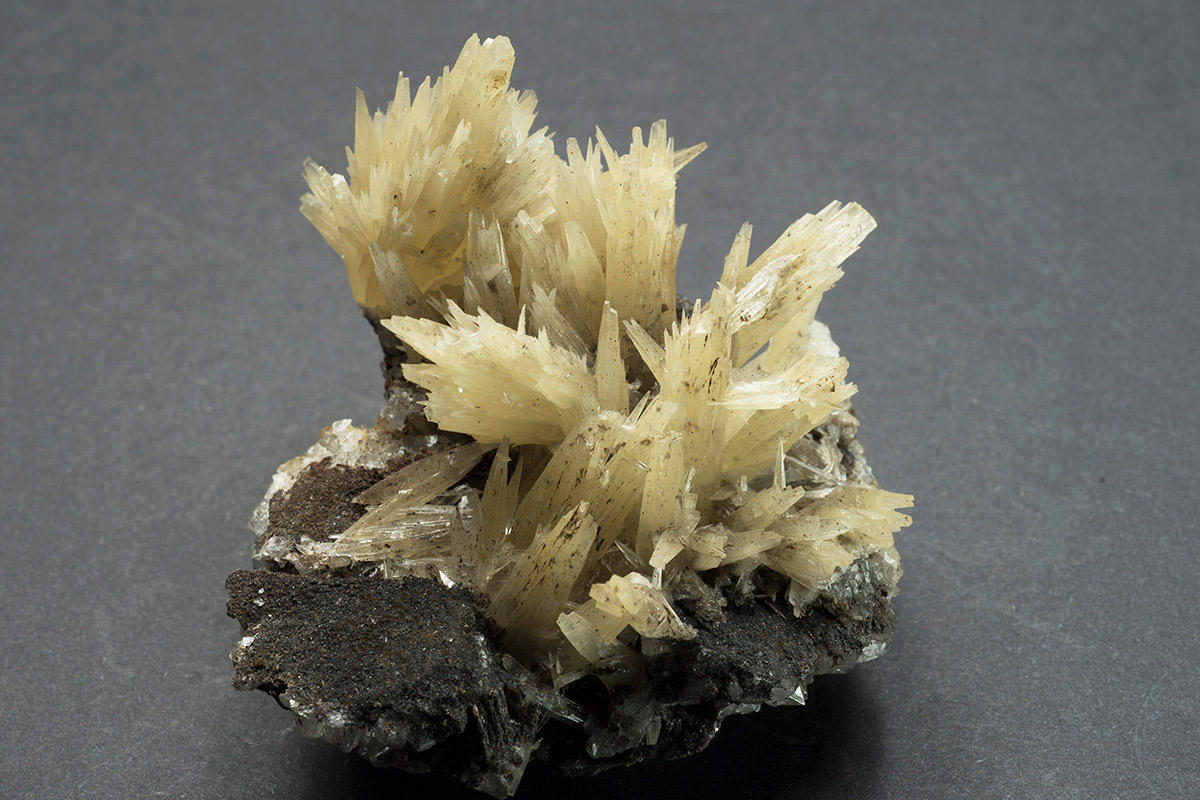
This vein produced an unusual range of specimens for Weardale such as quartz associated with cream coloured dolomite/siderite, aragonite and the manganese mineral todorokite. The aragonite groups with elongated cream to brown crystals up to 5cms long were some of the finest found in Weardale.
Cambokeels Mine, Eastgate, Weardale
Originally called Cammock Eels, the upper parts of the mine accessed via the horse level entrance produced large crystal beds of pastel coloured fluorite, but it was only after a decline was driven in the 1970’s to reach an un-mined sections of Slitt vein that Cambokeels showed its
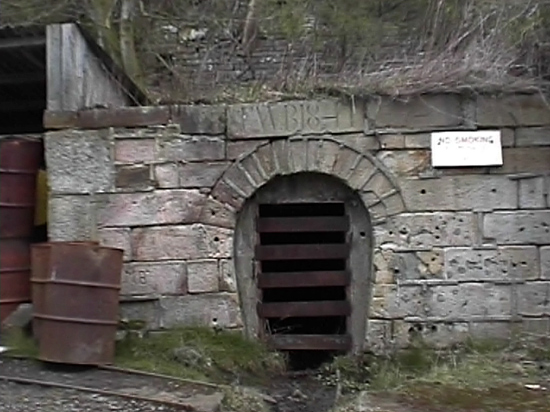
true potential as a specimen producer. The 325 ‘zinc flat’ level driven off the decline yielded many excellent specimens of clear to turquoise fluorite groups with colour-zoning and high lustre, often dusted with pyrite or coated with small sparkling quartz crystals or calcite. Cavities in these flats were so common that the area proved difficult to work, this and a fall in the price of zinc ore brought the drivage to an end whilst still in rich ore. The lower levels also produced some of the finest pyrrhotite crystals found in Britain.
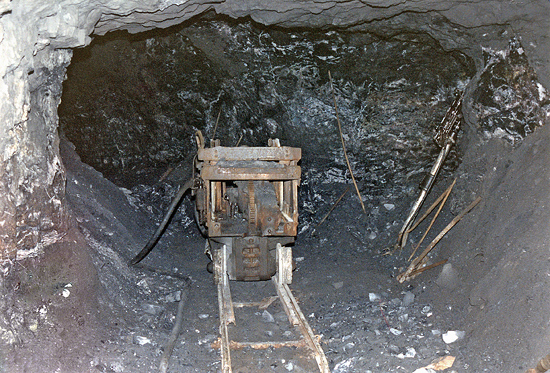
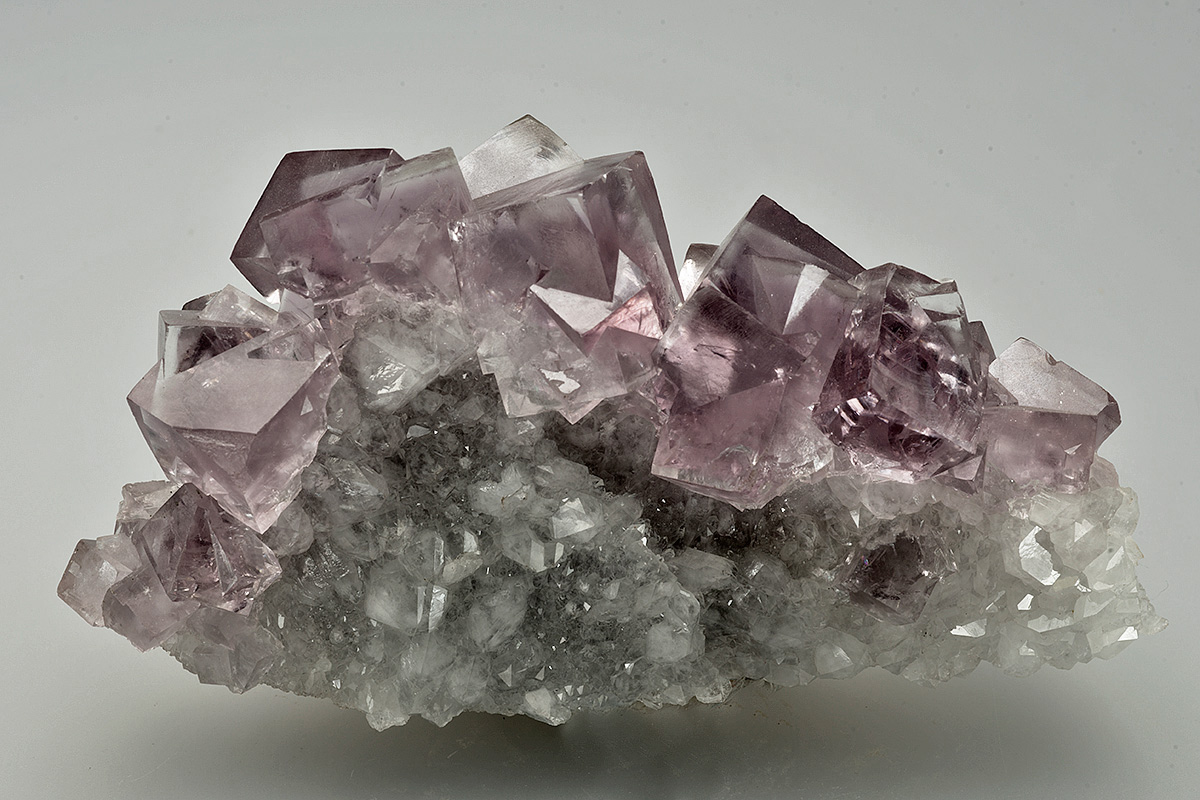
Chamosite of a grey-green colour frequently was a late stage coating on specimens Although the flats were rich in zinc few sphalerite specimens were recovered and galena seems to have be absent. On the 340, the lowest level, unusual deep pink transparent twinned fluorite cubes on quartz were found.
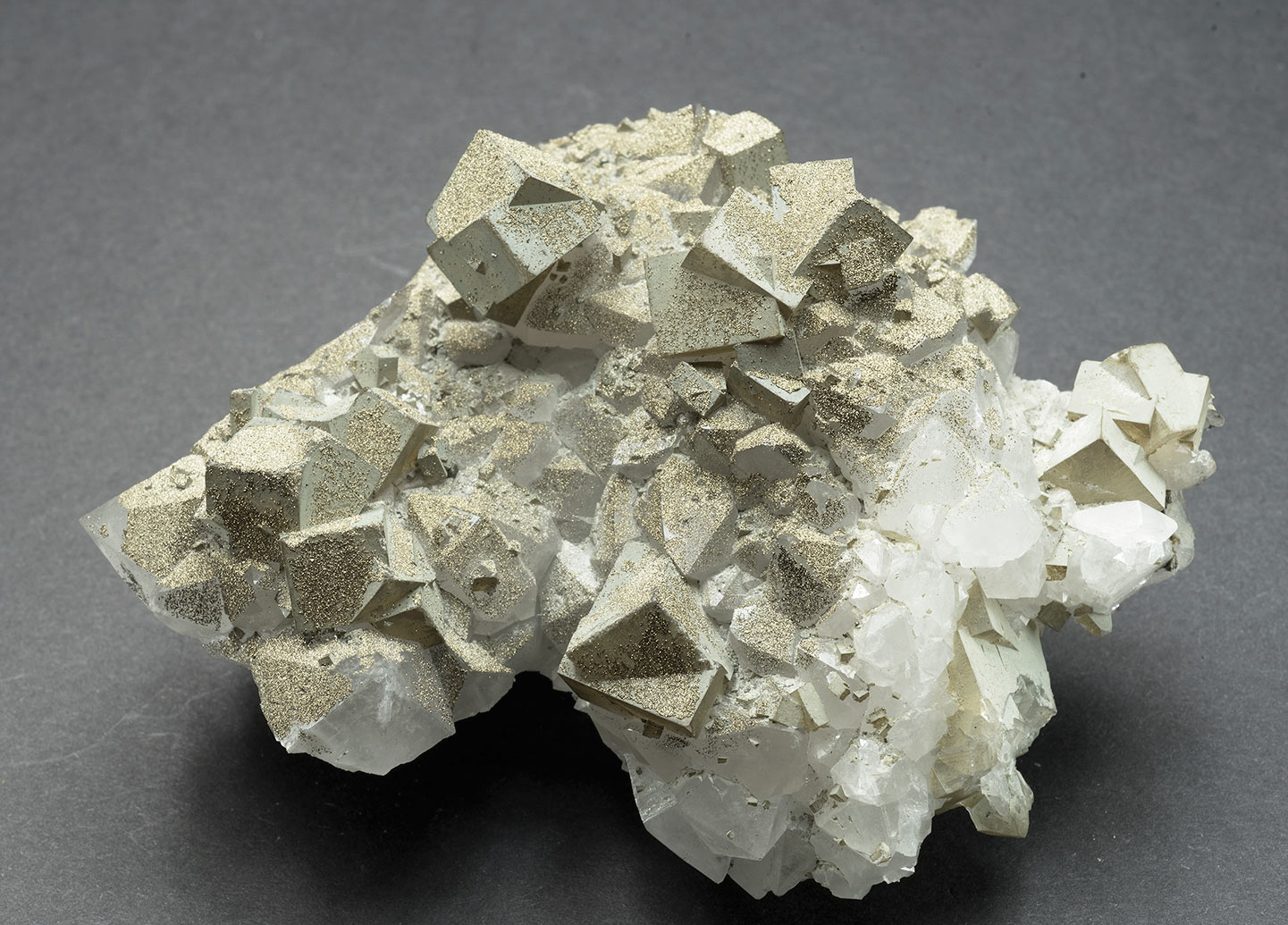
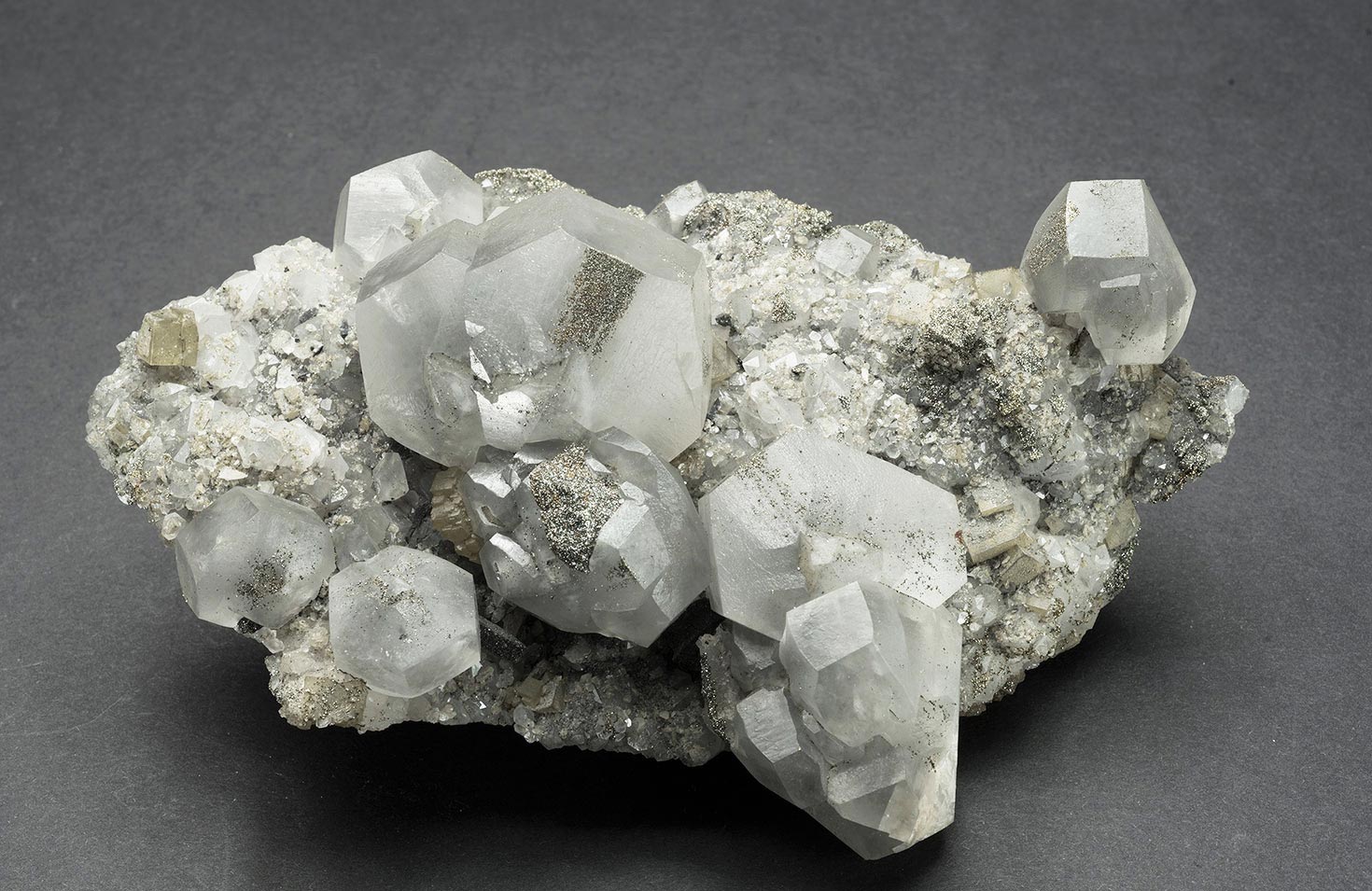
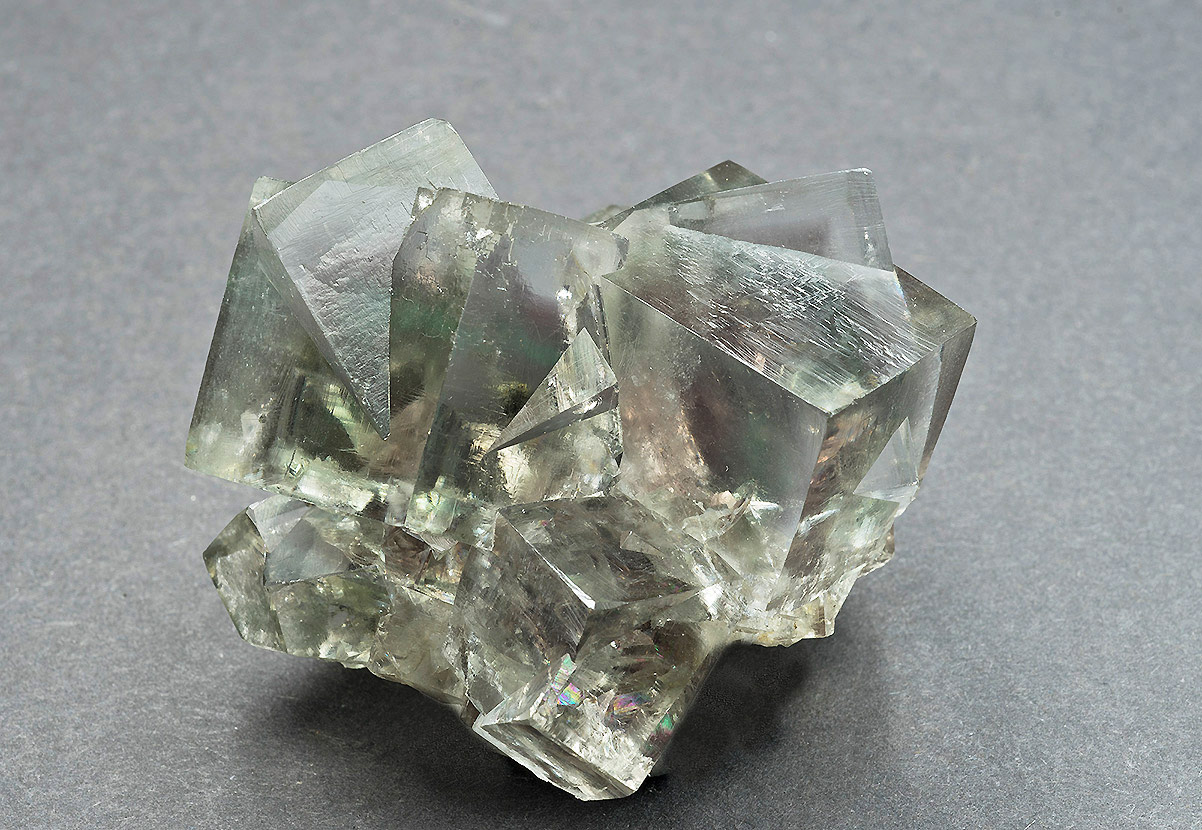
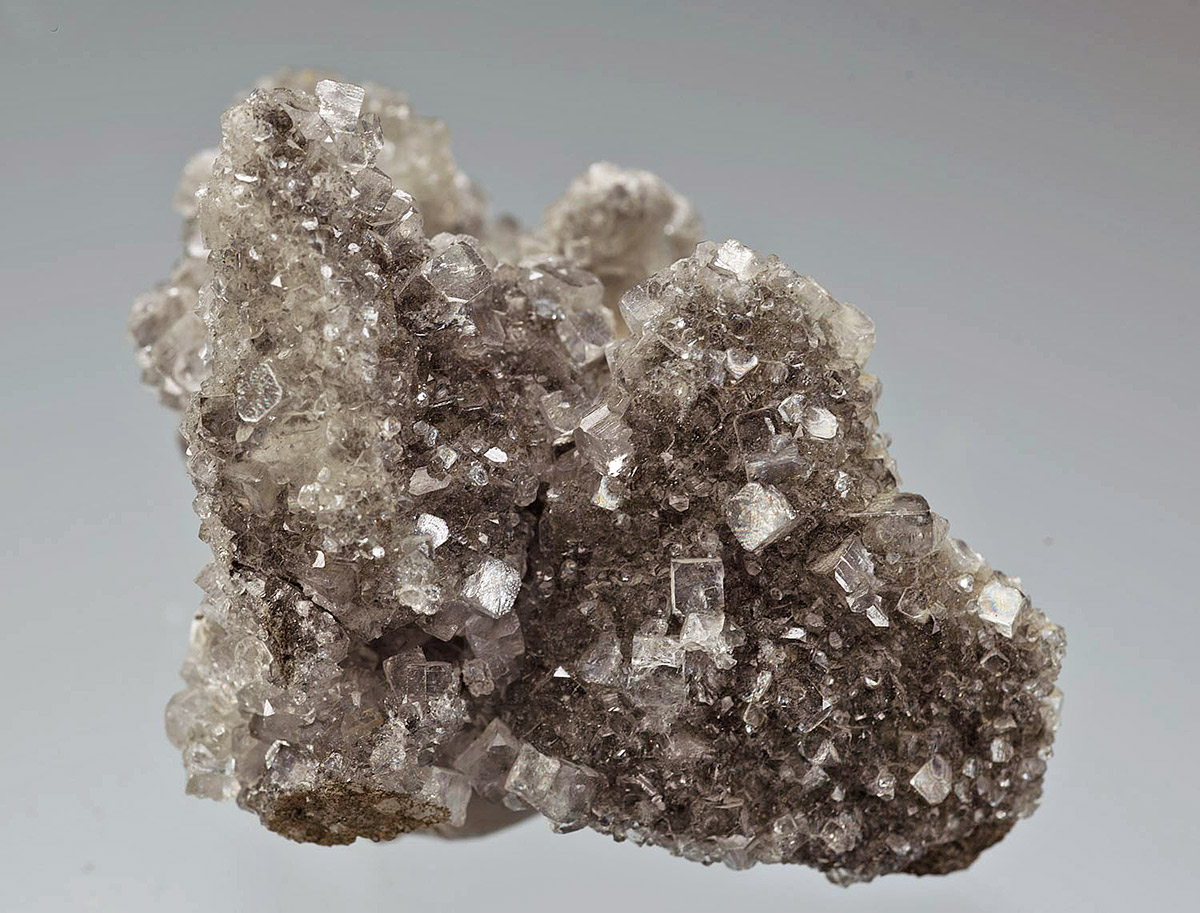
Cambokeels was the deepest mine in Weardale, the lower workings being below the Whin Sill. All levels at Cambokeels produced fine specimens of calcite in many different habits, probably the best in Weardale. Zeolite specimens are also recorded where the vein traversed the Whin Sill. The mine closed in 1989 and all the lower levels driven off the incline are now flooded.
Dry Pry vein, Salter’s Gate, Wolsingham
Anglesite is relatively rare in Weardale, but the Dry Pry vein produced well crystallised specimens with crystals up to 5 or 6mm associated with equally well crystallised cerussite, a little linarite and small quartz crystals. The secondary lead minerals and quartz occurred in large lumps of galena up to 20cms, the galena left over from when the mine closed, presumably there not being sufficient ore to warrant removing it for processing.
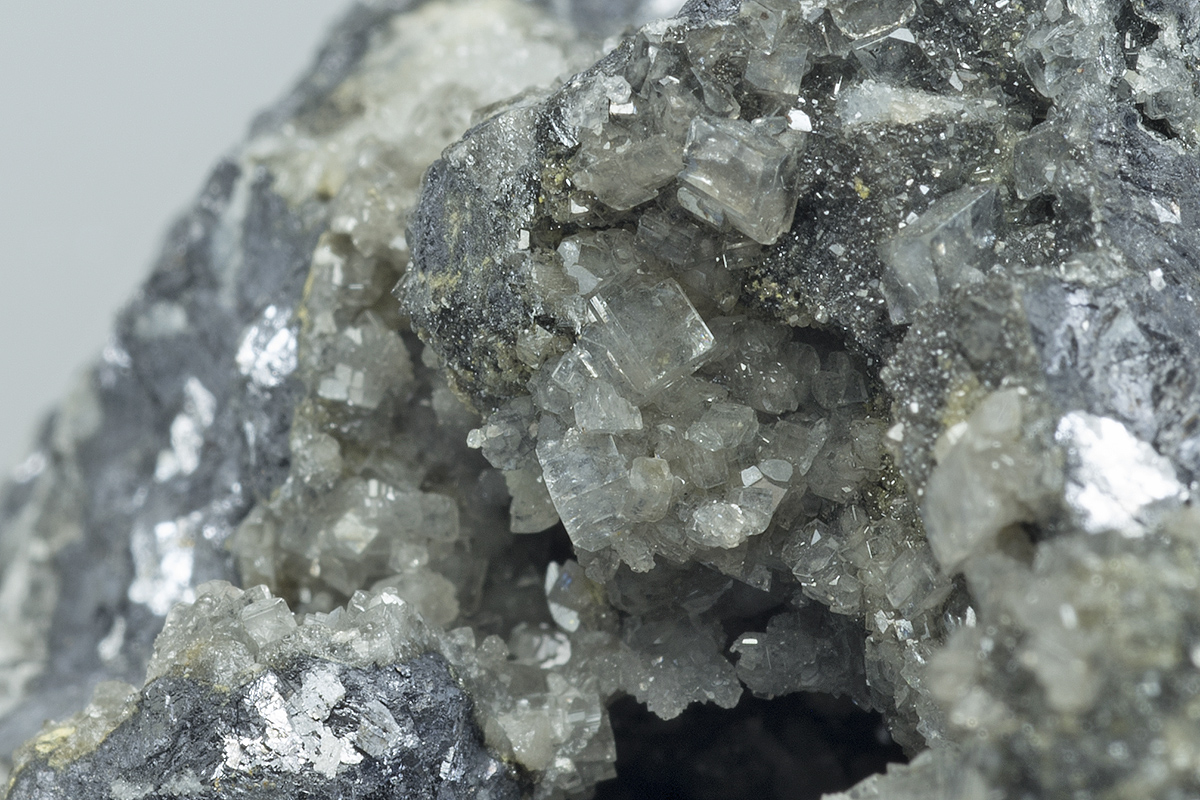
Eastgate Cement Quarry, Westgate, Weardale
A large disused quarry on the opposite side of the valley to Heights quarry, also known as Blue Circle quarry after the company that operated it for many years. Fluorite specimens recovered were frequently twinned, predominantly green in colour although occasionally rich transparent yellow specimens with a clear outer zone were found. Purple phantoms are common in the green fluorite, which is a useful way to help distinguish specimens from those occurring at the nearby Heights quarry as is their darker colour in artificial light. Surface etching was a common feature on the crystal faces possibly caused by acidic solutions in the surrounding mud. The quarry closed in 2003 and has been landscape to remove most evidence of quarrying.
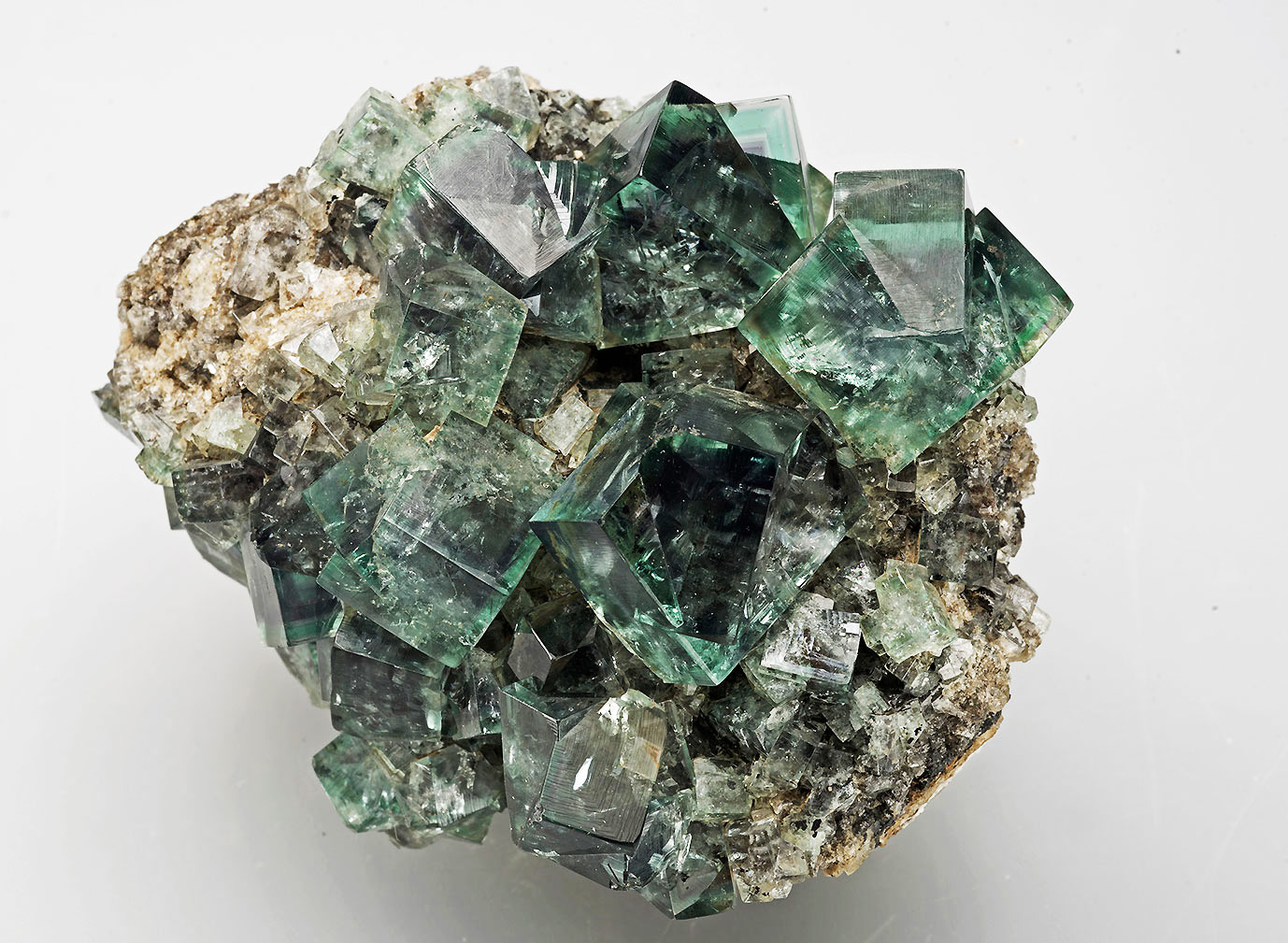
Lady Annabella Mine, Westgate, Weardale
For some time excellent specimens from Eastgate cement quarry have appeared on the specimen market so in 2020 Ian Bruce of UK Mining Ventures obtained permission to establish a specimen recovery operation in the quarry.
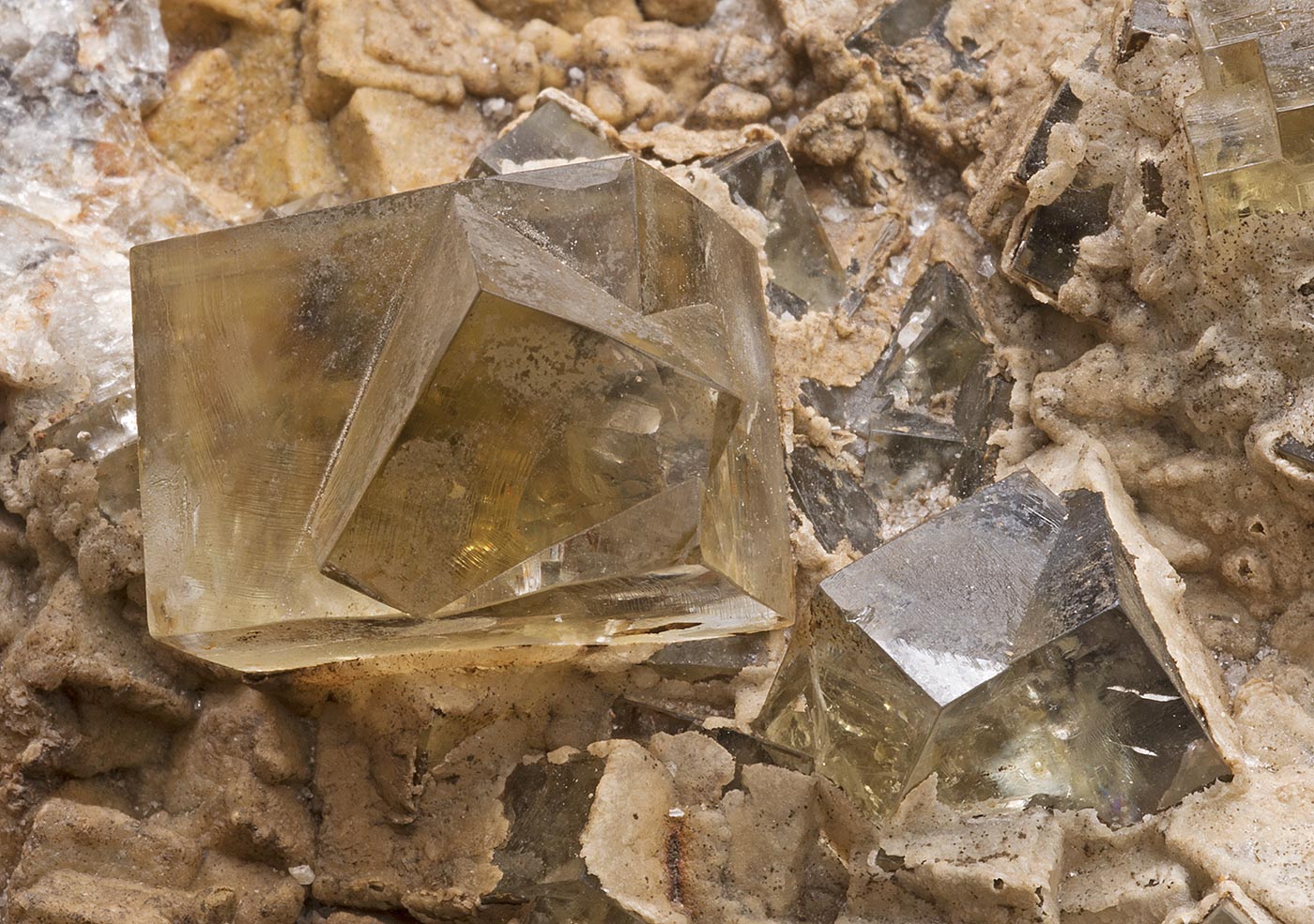
The venture, named after his daughter born earlier in the year, has already had some success in the few weeks it has been operating, the upper flats in the Great Limestone hosting a succession of small to medium size cavities lined with fluorite accompanied in some cases by calcite and galena. The fluorite comes in an array of colours - green, purple, yellow, straw and brown, adjacent cavities often containing different coloured crystals. The extensive vein system crossing the old quarry suggest many fine and unusual specimens will be found here.
Frazer’s Hush Mine, Rookhope
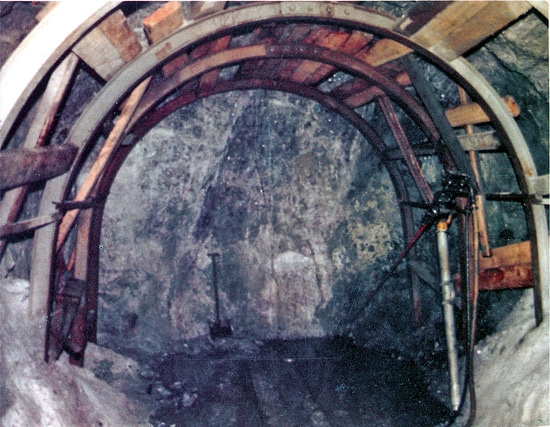
Quite a prolific specimen producer, especially since the 1980s when Weardale Minerals Ltd. acquired the operation. Many specimens came out of a single huge cavity hit during 1990 in the Great Limestone, stretching from the 340 level down to the 325 level, which produced beds of transparent twinned purple fluorite crystals typically up to 4 cm some coated with calcite, sphalerite or galena crystals. The best crystals were amazingly lustrous, possibly better than any others found in the district.
Elongated ‘Floaters’ often with stepped crystal faces similar to those found at Blackdene were found but sparingly. Some of the largest cubes in Weardale came from Frazer’s - I have seen near complete cubes 25cm (10”) across and 10-15cm (4”-6”) cubes were not uncommon.
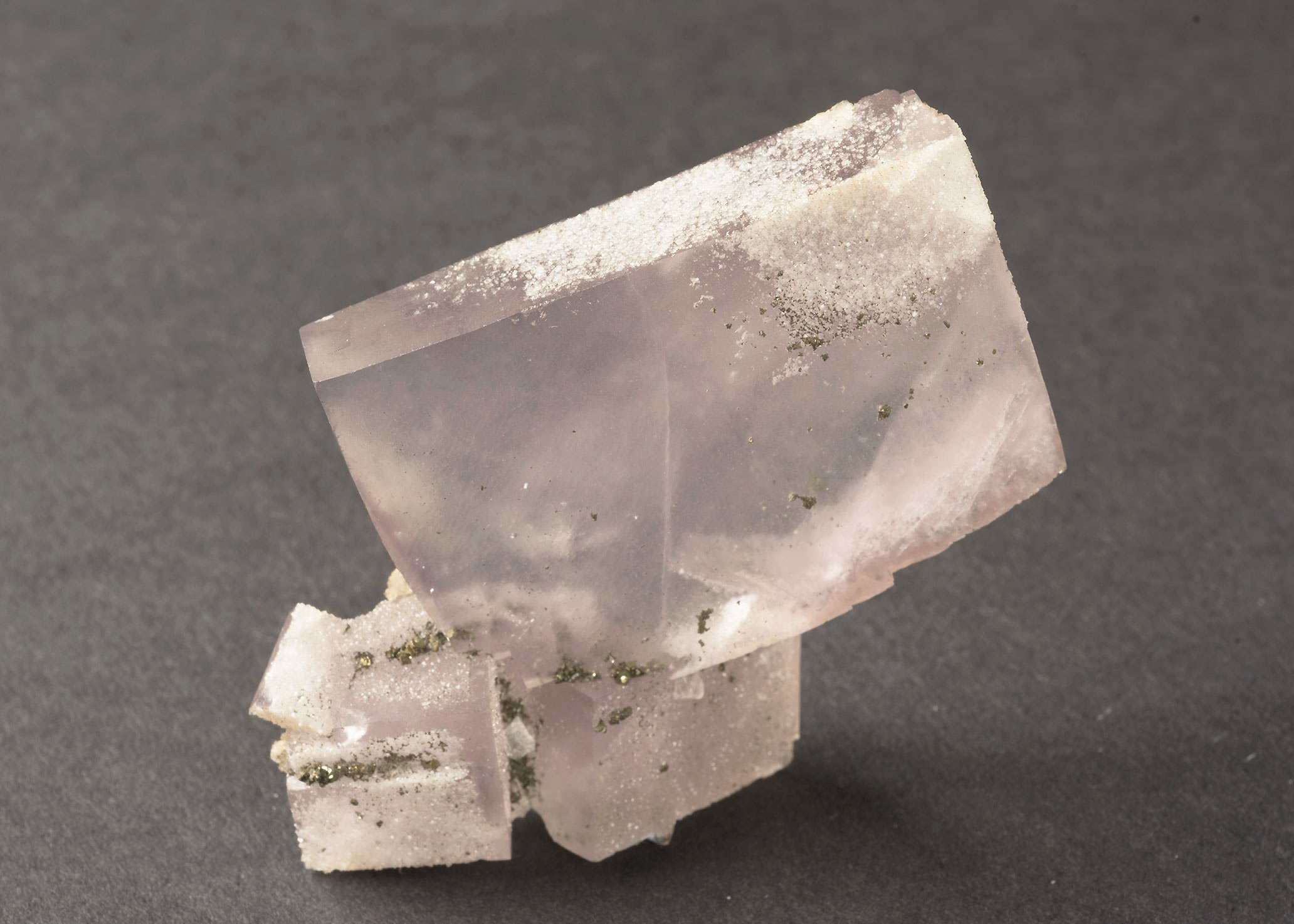
Green fluorite was rare but occasionally turned up from the workings on the 280 level either on its own or partially coated with quartz. Besides fluorite, groups of bright galena crystals were recovered as were specimens of nail-head calcite crystals coating fluorite cubes, gemmy sphalerite on quartz from the 340 level and bismuthinite. The higher levels reached by the Greencleugh decline produced large purple-white opaque fluorite cubes, twins up to around 3cms of good colour and form though often with frosted faces. The occasional ‘jack-straw’ cerussite turned up from here but not in the quantities that came out of Redburn mine.
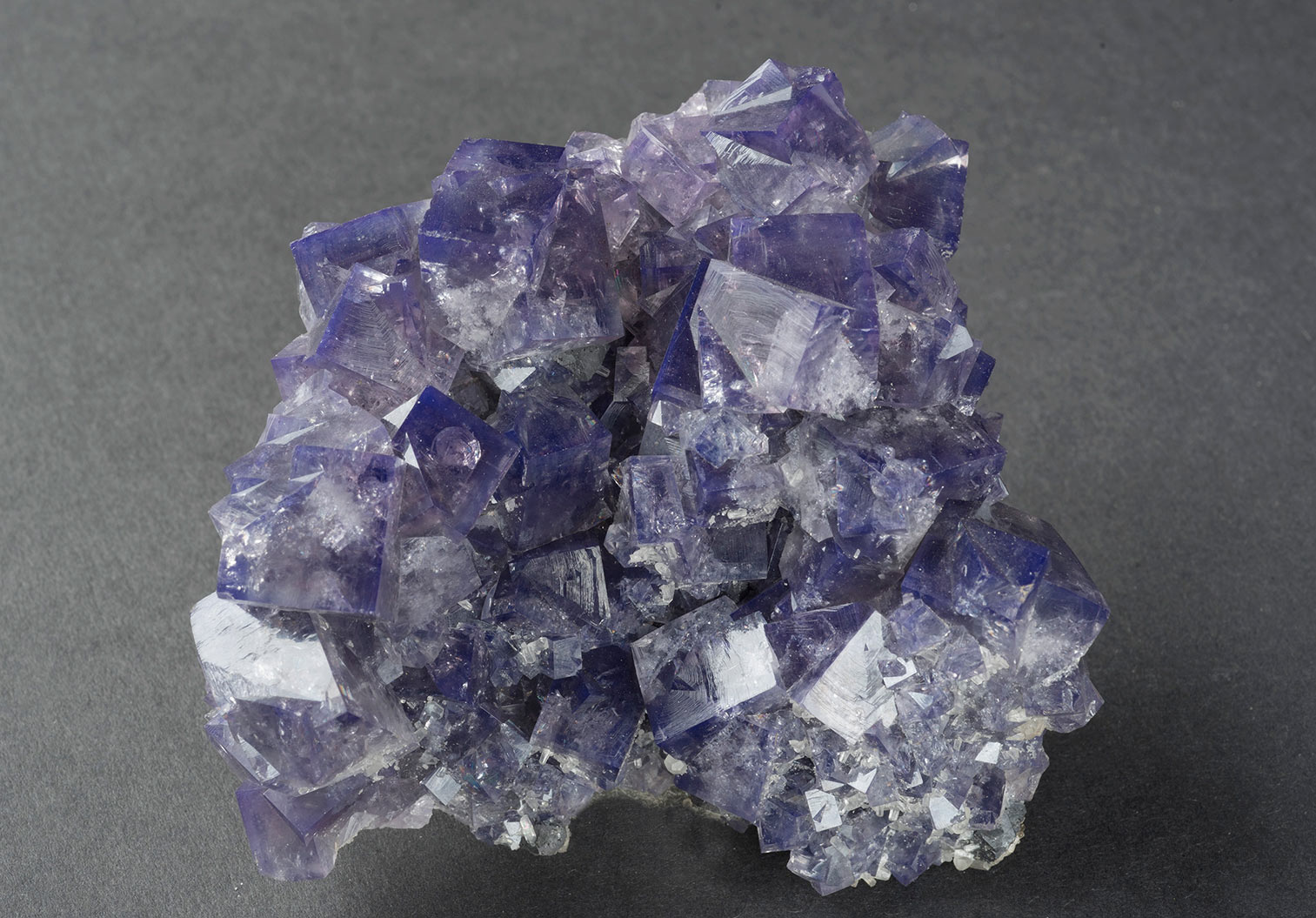
Levels here were assigned numbers determined by their vertical level in fathoms relative to sea-level so that the reference number of levels decreased with depth. However, confusingly, at Cambokeels the level numbering was calculated as the vertical distance from the entrance to the mine so a level with a higher number refers to a deeper level. The last level to be worked at Frazer’s, the 260level produced small but outstanding purple fluorite groups. The mine closed in 1999 making it the last commercially worked mine in Weardale.
Greenlaws Mine, Westgate, Weardale
A number of attempts have been made since the 1960’s to re-work the mine for mineral specimens and for the last few years an active dig has been taking place, entry to the flats being gained through a shaft high up on the Fells. Earlier efforts produced some large un-twinned purple cubes but more recently very good specimens have been mined including some unusual multi-faced floaters and specimens in a wide range of colours including yellow and a lovely cranberry purple, unique to the mining district.
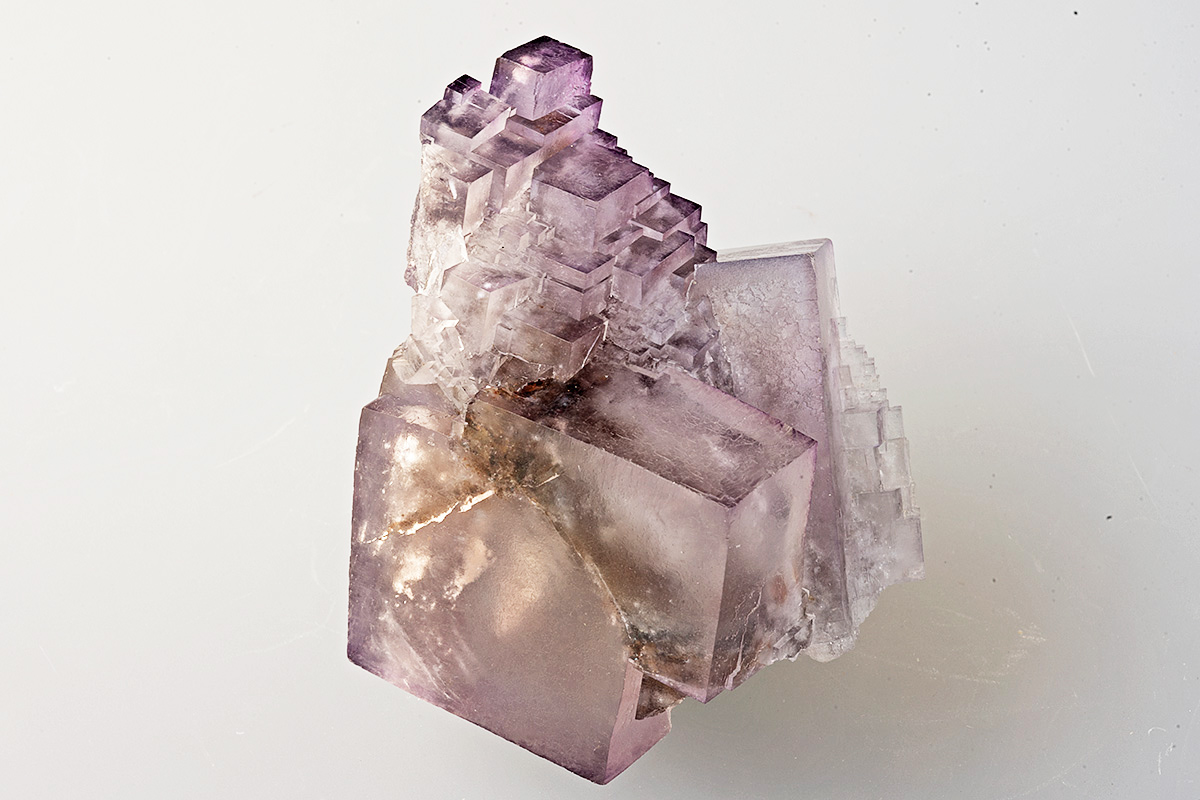
The group led by Peter Ward have cleared the access shaft and worked their way through into the main flats with is proving to be rich in fluorite lined cavities. For more information on the group they have a Facebook page: -
https://www.facebook.com/UK-Fluorite-Greenlaws-Mine-112570490440280/
The lowest level for a time was tried and yielded some pleasing specimens, the cubes being on the small side but usually twinned with a good lustre and associated with sphalerite. Old records suggest there are many miles of flats in the mine to explore giving the possibility of many fine specimens.
Groverake Mine, Rookhope
Groverake mine produced characteristic specimens of colour banded chalcedony often coating large cubes of fluorite with a second generation of smaller cubes. Quartz crystal beds were common. It has been worked sporadically for most of the 20th Century, Weardale Minerals re-opening it in 1985 working it in conjunction with Frazer’s Hush until closure in 1999.
Heights Quarry and Mine, Eastgate, Weardale
Heights quarry and mine have produced some of the finest quality specimens of lustrous green fluorite with inter-penetrant transparent twins typically to 4cms. Its appeal has been the range of fluorite colours – green, purple, colourless with a wide range of colours in-between. Fluorite cubes with included ‘bubbles’ were not uncommon.
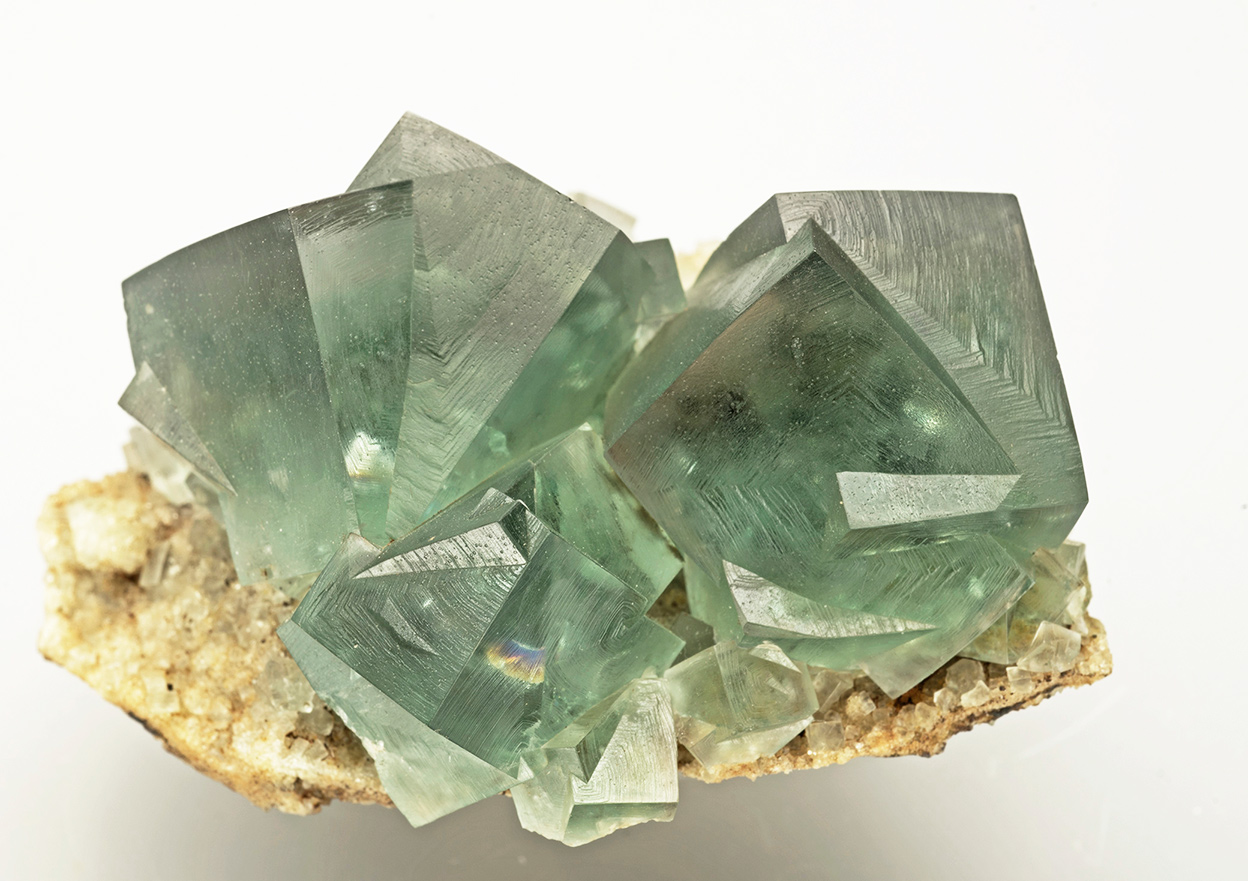
A further characteristic of Heights specimens besides the wonderful lustre of the fluorite is the aesthetic combination with other species such as galena, siderite or calcite. Very large opaque green fluorite crystals up to10cms were found in the West Cross vein.
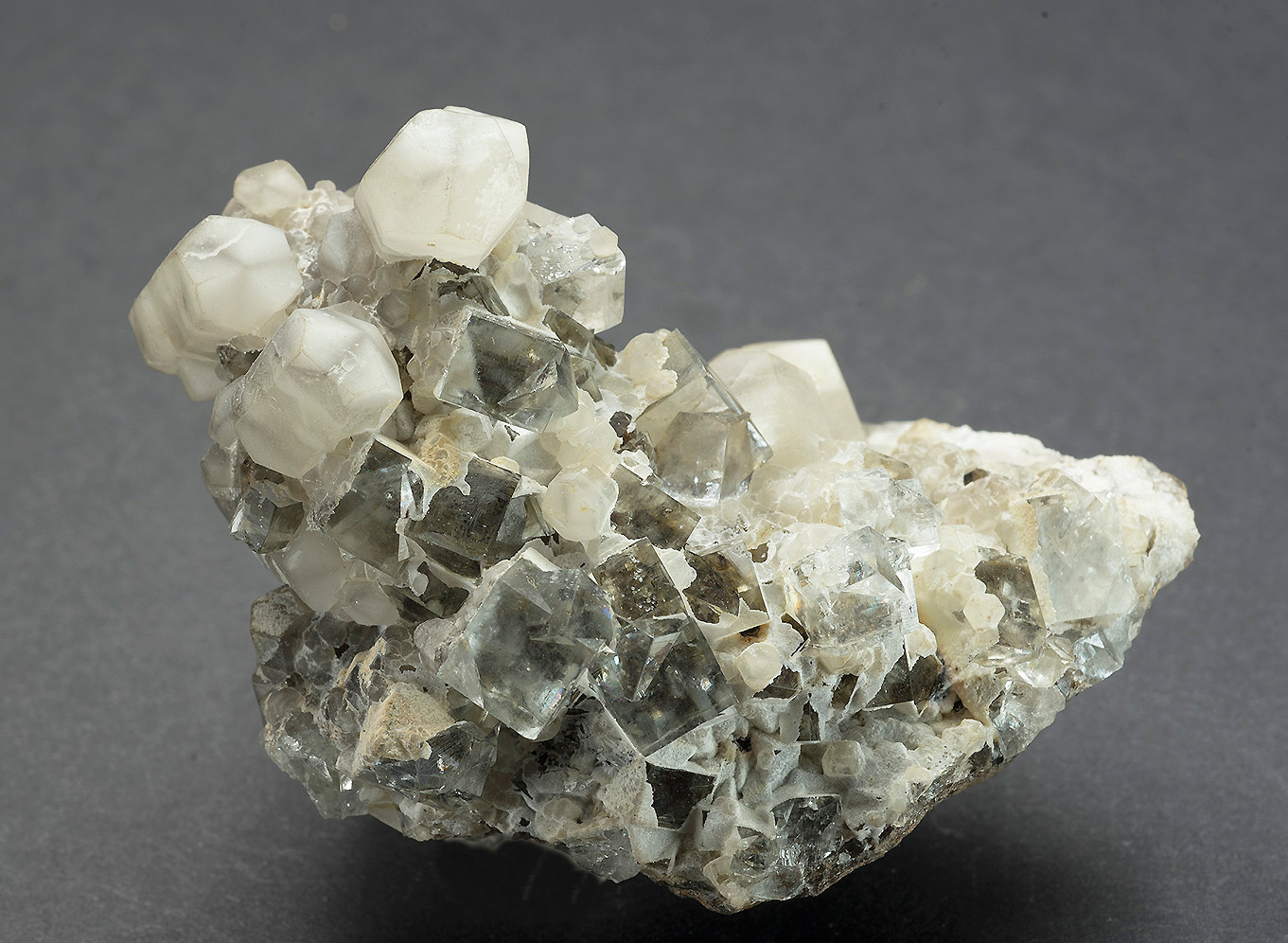
Some of the fine early specimens from here were from Heights mine which worked ironstone flats north of the quarry and was accessible to collectors at times in the second half of the 20th Century. Occasionally as the quarry expands the old mine workings are exposed.
Hollywell Mine
An old lead mine worked in the 19th Century; the level exposed by later quarrying as the Rogerley quarry workings moved eastwards. The flats in the Great Limestone show significant fluorite mineralisation although much has undergone strong alteration. Unaltered fluorite commonly shows twinning and colour zoning characteristically with green centres surrounded by a purple outer zone.
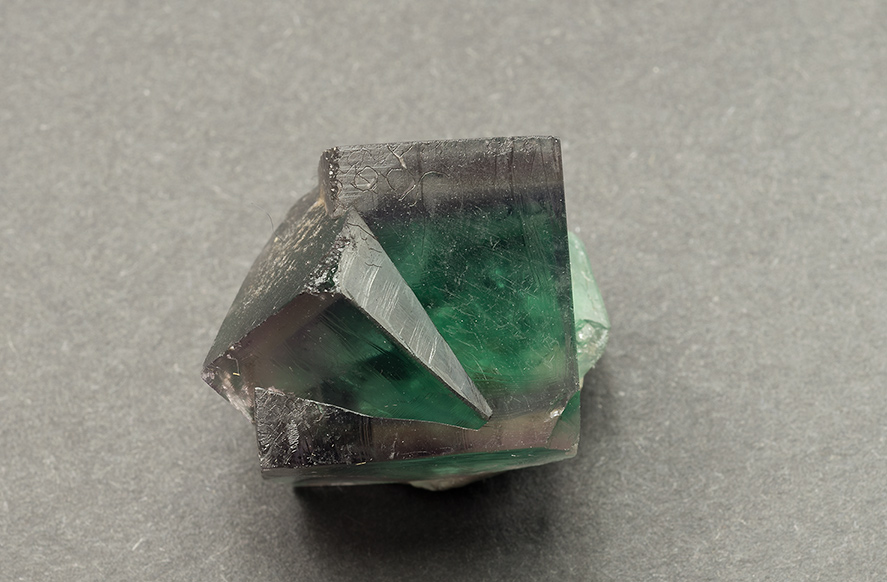
Lanehead Quarry, Stanhope, Weardale
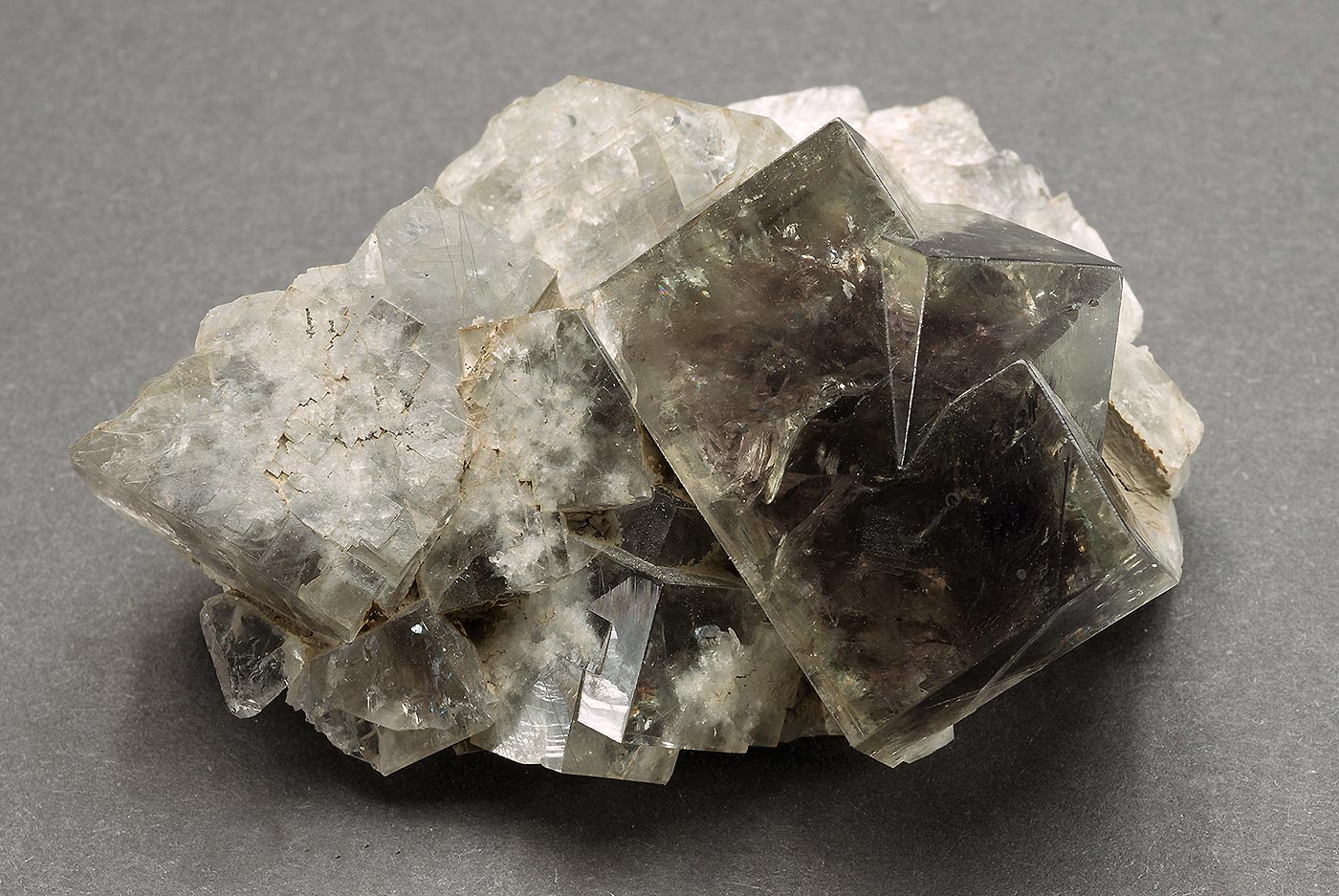
A lesser known Weardale specimen location where a number of veins cross the old quarry workings. Fluorite occurs in shades of pale green to tan coloured crystals sometimes accompanied by calcite and quartz. Rippon’s level was driven below the limestone.
Middlehope Shield Mine, (White’s Level), Westgate, Weardale.
In 1819 Edward Daniel Clarke, (then Professor of Mineralogy at Cambridge University) made one of the earliest descriptions of fluorite crystallisation based on a specimen of fluorite from Middlehope Shield mine.
The green fluorite from here is distinctive; usually displaying bevelled edges and formed on a friable sandy coloured matrix. Green fluorite is not uncommon in Weardale, which could make pieces from the location difficult to identify but the matrix is characteristic as most of the locations that it can be confused with are on grey to brown limestone originating in ironstone flats.
Newlandside Quarry, Stanhope
The western quarry (west of the Stanhope to Bollihope road) produced mainly small purple fluorite cubes although most were twinned. The Eastern quarry was noted for the occasional group of larger twins - up to about 3cms of an unusual transparent dark blue/violet colour many with good lustre. In recent times the western quarry has been sporadically worked on a small scale for limestone fill.
Redburn Mine, Rookhope
Large beds of purple fluorite in small crystals occurred here usually on quartz but it was the masses of Jackstraw cerussite that it became famous for. These specimens were the best found in the district, often quite large and tinged green, blue or brown depending on the traces of other minerals occurring with it. The mine which worked Red vein closed in 1981.
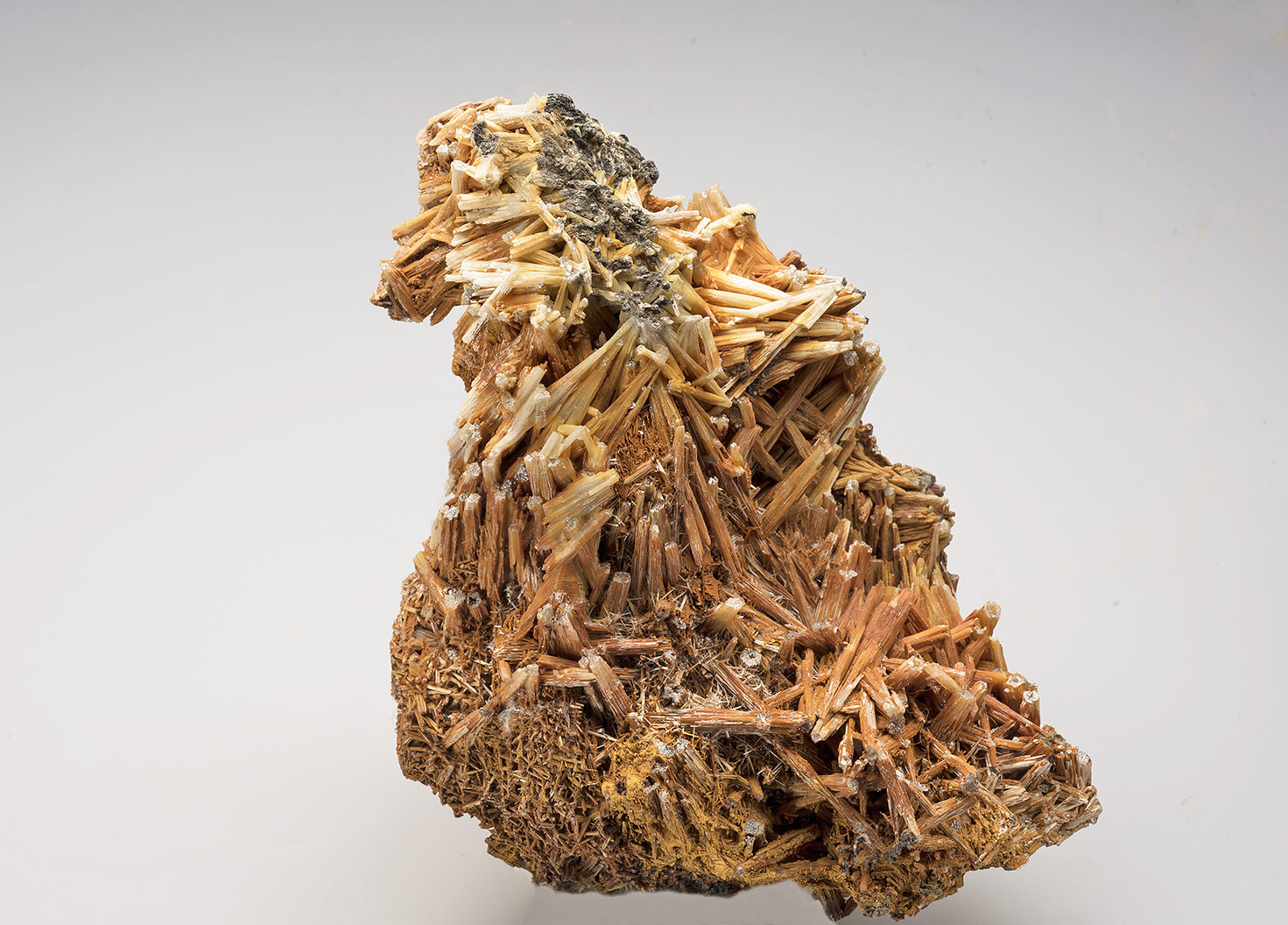
Rogerley Mine, Frosterley, Weardale
A small specimen mine driven in the face of a disused quarry initially developed by Lindsey Greenbank and Mick Sutcliffe and since 1998 by UK Mining Ventures for fluorite
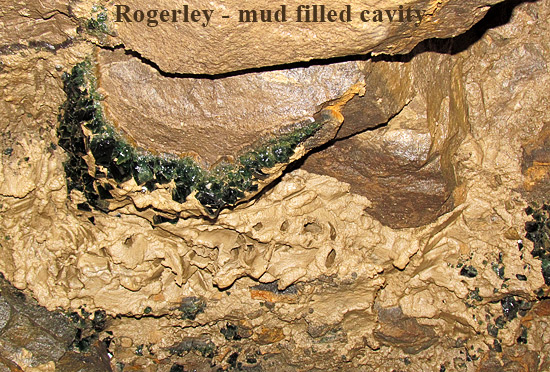
specimens. Lindsay and Mick produced a steady supply of good specimens initially from an adit driven into the vein at the lower flat horizon in the Great Limestone and subsequently into the high flats which proved more productive of specimens.
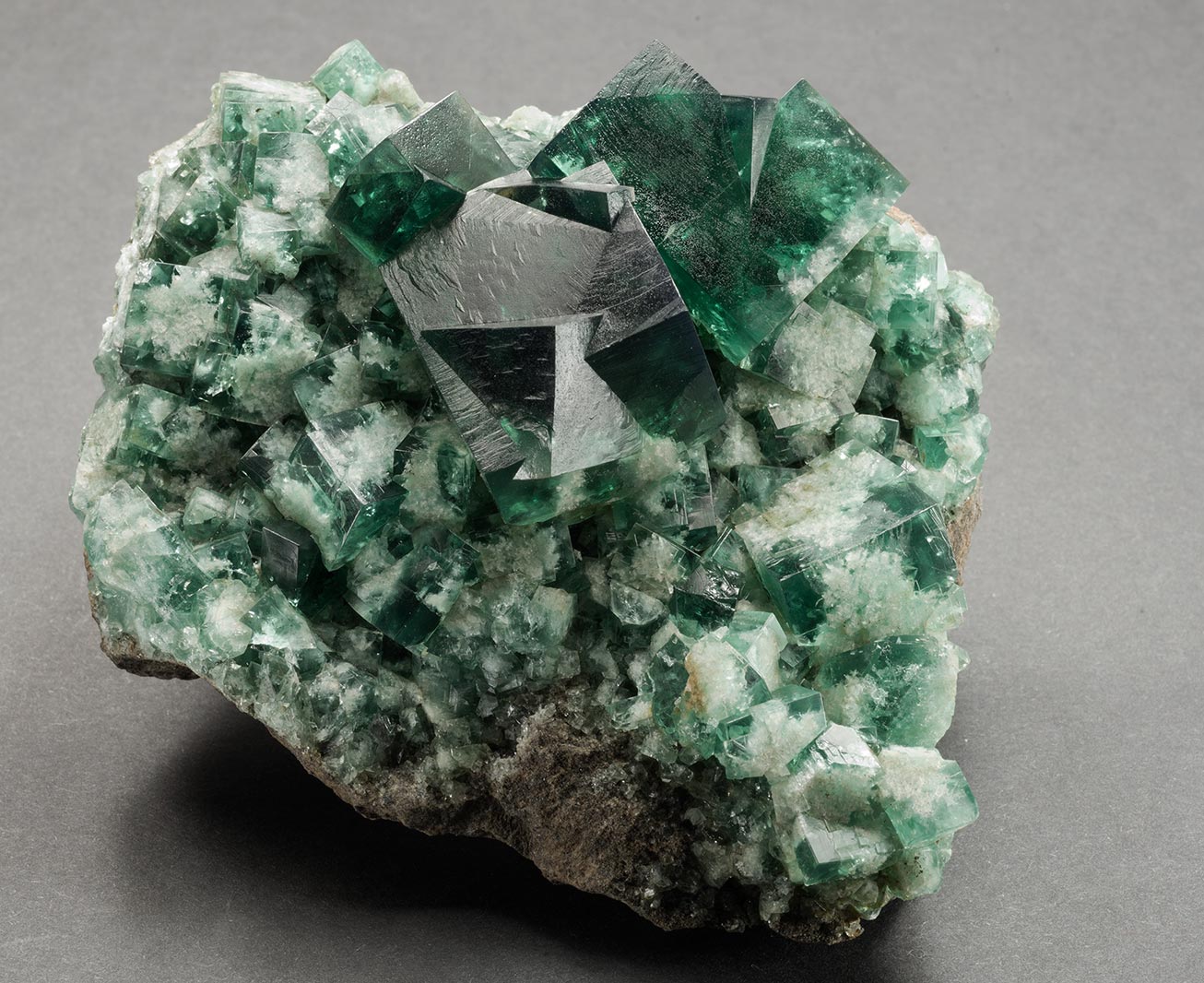
Health problems forced the sale of the mine to UK Mining Ventures, a small American consortium led by Cal Graber and Jessie Fisher who mined it successfully until 2016. At that date Crystal Classics took over UK Mining Ventures and have been operating the mine ever since. It has proved to be a prolific source of mineral specimens, the green fluorite from here, somewhat darker than Heights, rivals any found in the dale and is highly fluorescent.
The fluorite occurs in flats found to the sides of the vein with larger cavities being named to allow collectors to pinpoint exactly where their specimen came from. The vein itself sporadically turns up large purple or amber fluorite cubes with quartz. Fluorite is occasionally found with other mineral species such as galena in both cubic and octahedral habits and aragonite but not in the same quantities as say Blackdene or Heights.
Diana Maria Mine.
In the western part of Rogerley quarry (disused) about 300 metres from the portal of Rogerley mine a vein exposed in the quarry face had been known for some time, Lindsay Greenbank and Mick Sutcliffe naming it the Sutcliffe vein. However working the Greenbank vein at Rogerley mine took precedence and it was left unworked until In 2017 Ian Bruce of UK Mining Ventures realised the potential of the vein for specimens and began working the vein first through an opencast operation and subsequently by an adit driven on the vein.
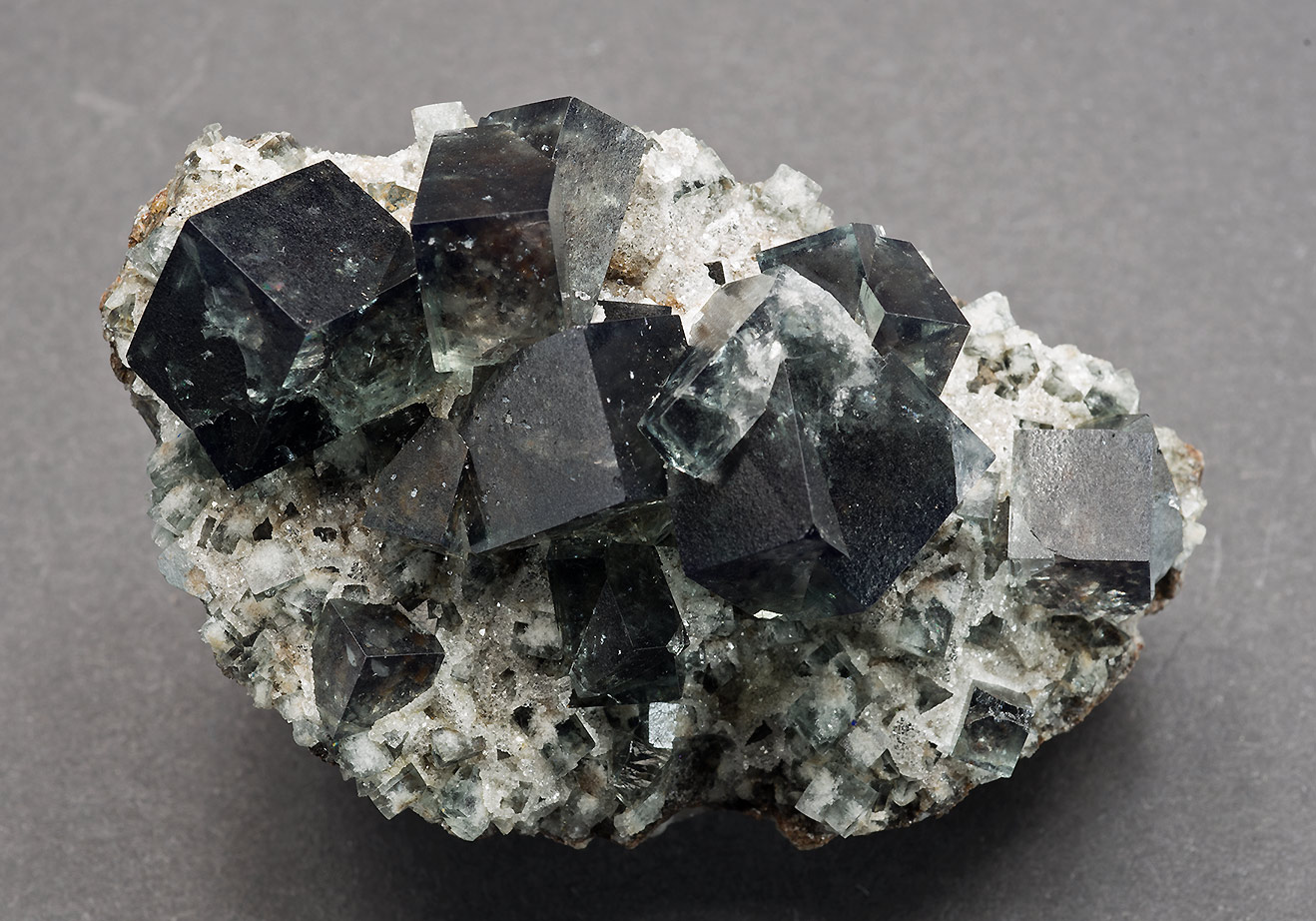
Flats were soon evident associated with the vein and these have proved to be a source of many fine fluorite specimens – characterised by their variety of colour, good lustre and propensity of the fluorite to form twins. The Diana Maria workings are now close to where the Sutcliffe vein is predicted to cross the line of the Greenbank vein. Vein junctions are generally known to strengthen the associated veins and mining is going forward to establish whether this is the case here. Recent operations here have also involved working a parallel vein, the River Catcher vein from which specimens have been recovered with similar characteristics to those from the Diana Maria mine. UK Mining Ventures has a web site and a Facebook page for their mining operations in Weardale: -
http://www.ukminingventures.com/
https://www.facebook.com/ukminingventures/
Stotsfield Burn Mine, Rookhope
Specimen quality fluorite was not common from Stotsfield Burn; no flats being recorded as occurring here. However Red vein itself occasionally produced lustrous, transparent grey-green and purple fluorites the best of which are comparable in quality to good Frazer’s Hush or Blackdene pieces. Galena specimens were also found consisting of modified cubes to 3cms and occasional cerussite specimens similar to Red Burn. The mine closed in 1966.
St Peter’s Mine, Sparty Lea, Allendale.
Worked for fluorite by the Weardale Lead company in the 20th Century although originally opened in 1855 and operated by the Blackett company as a lead mine. In the 1930s Sir Arthur Russell managed to acquire a quantity of unusual apple-green fluorite specimens, these, and the rest of Russell’s collection now preserved at the Natural History Museum in London. Commercial mining came to an end in 1946.
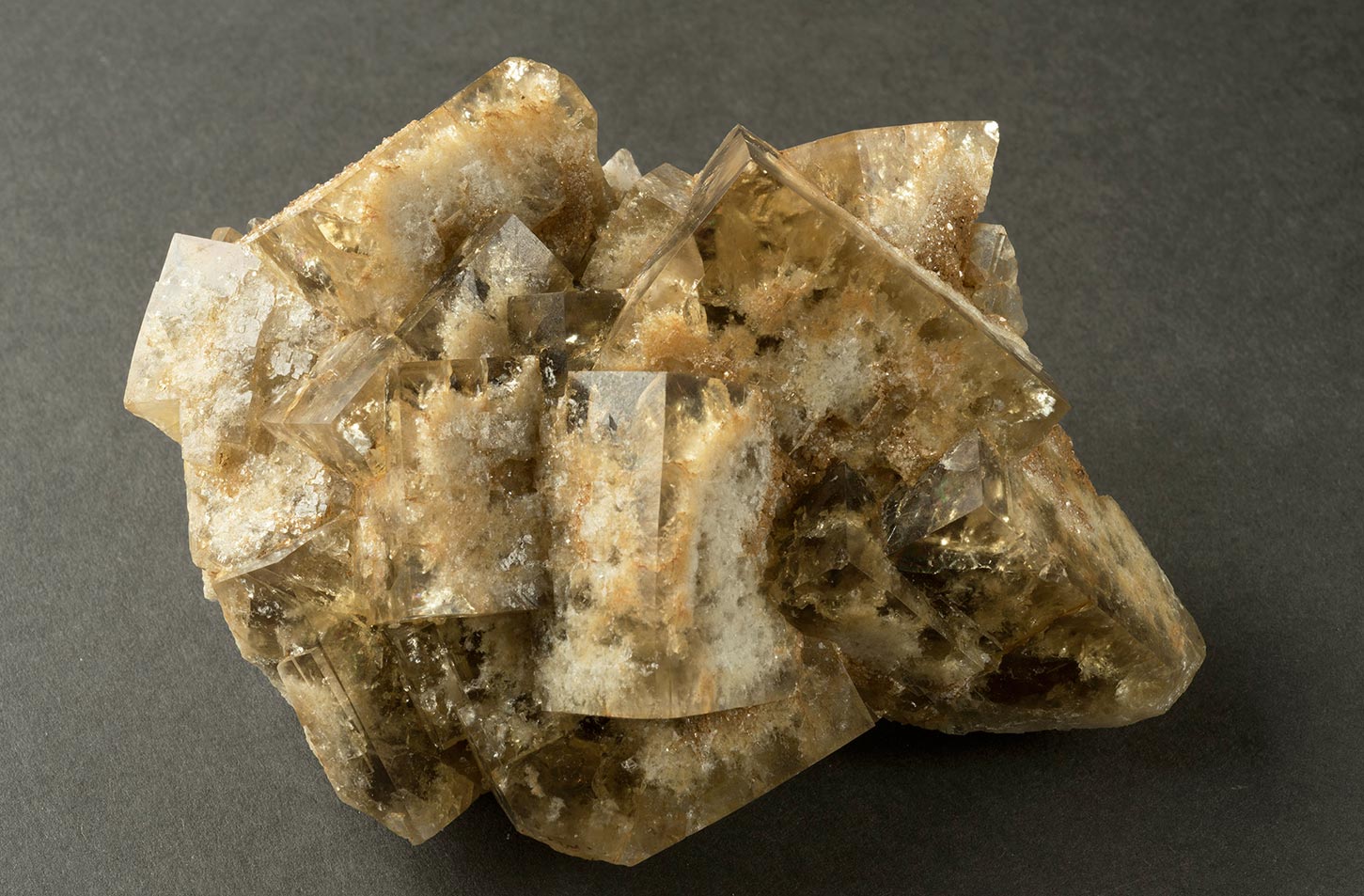
A group of mineral collectors became aware of these specimens and in the mid-1990s they leased the rights to work the mine (using hand tools only) for specimens using the main shaft for access. Many unusual straw to light brown fluorite groups were recovered, many of excellent quality with cubes up to 10cms (4”) some partially coated with siderite however none of the apple green fluorite was ever found.
West Pasture Mine, Stanhope, Weardale
Beautiful apple-green fluorite cubes have been collected from the flats in recent years although the entrance has now partly fallen in. The colour is particularly unstable in sunlight and alters to a pale purple-brown. larger purple fluorite crystals have also been recovered.
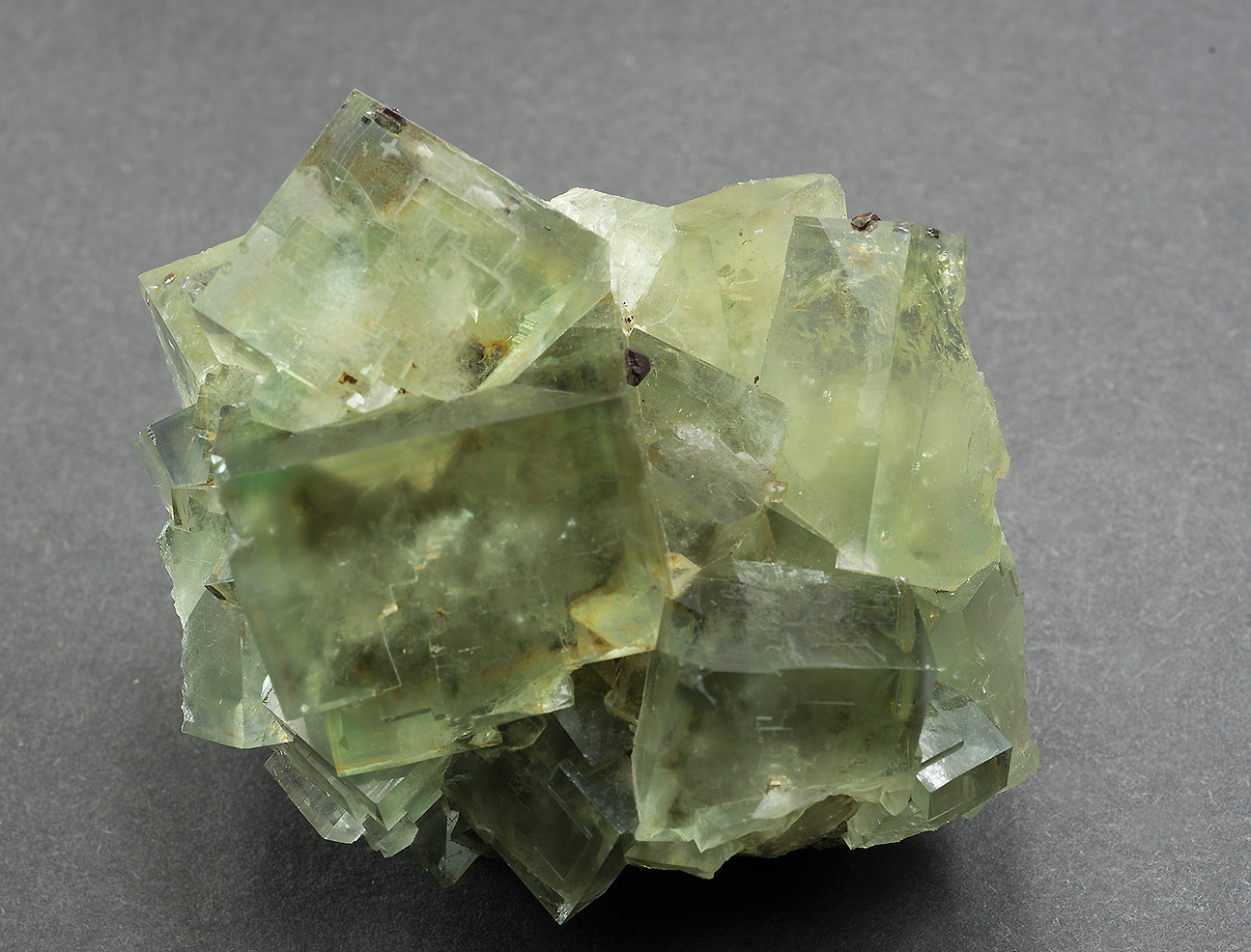
Whiteheaps Mine, Hunstanworth, Northumberland
Light pastel coloured groups of fluorite with crystals up to 4cms often associated with quartz and occasionally of a deeper purple colour were collected whilst the mine was worked. Sphalerite and calcite specimens occasionally turn up on the specimen market, but I haven’t as yet seen a galena specimen from here. The mine closed in 1980.
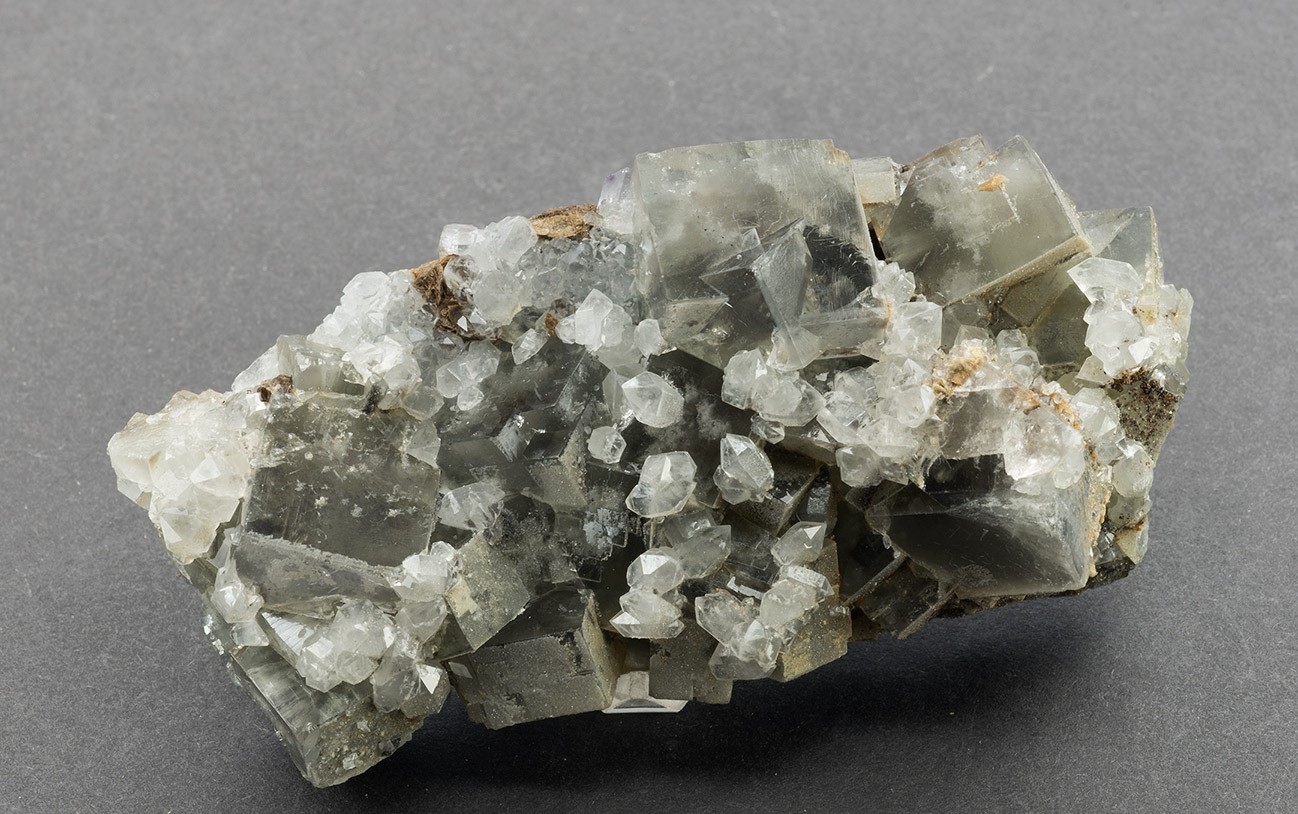
Safety and Access
Underground workings and mines are dangerous and should not be entered. They are unstable, often flooded and many contain toxic gases. Before visiting any quarry, mine, or mineral location permission to enter/collect must be obtained first and its SSSI status checked.
Recent Items for Sale
Minerals of the English Midlands

Minerals of the English Midlands

Mailing List
Interested in our mailing list? Get in touch via the email address on our contact page and we will add you to the mailing list.


